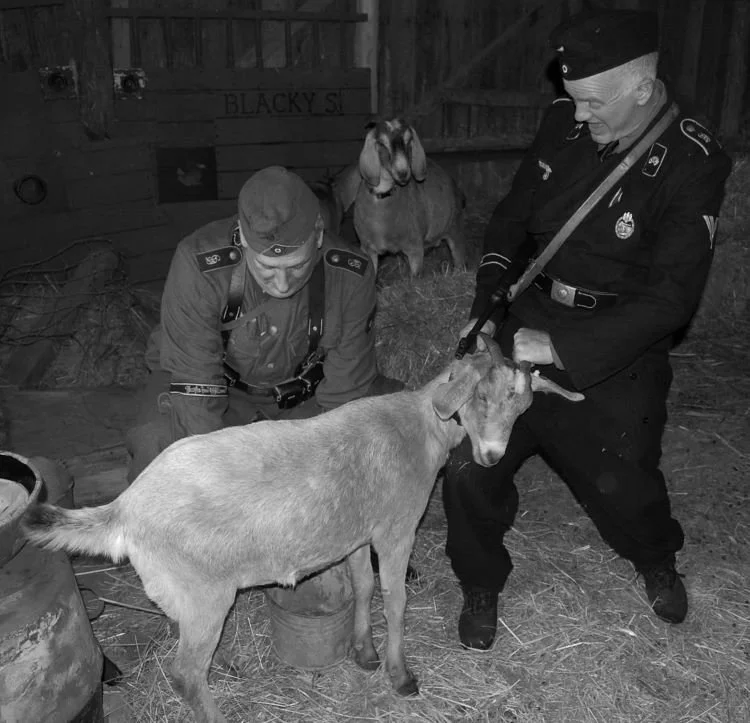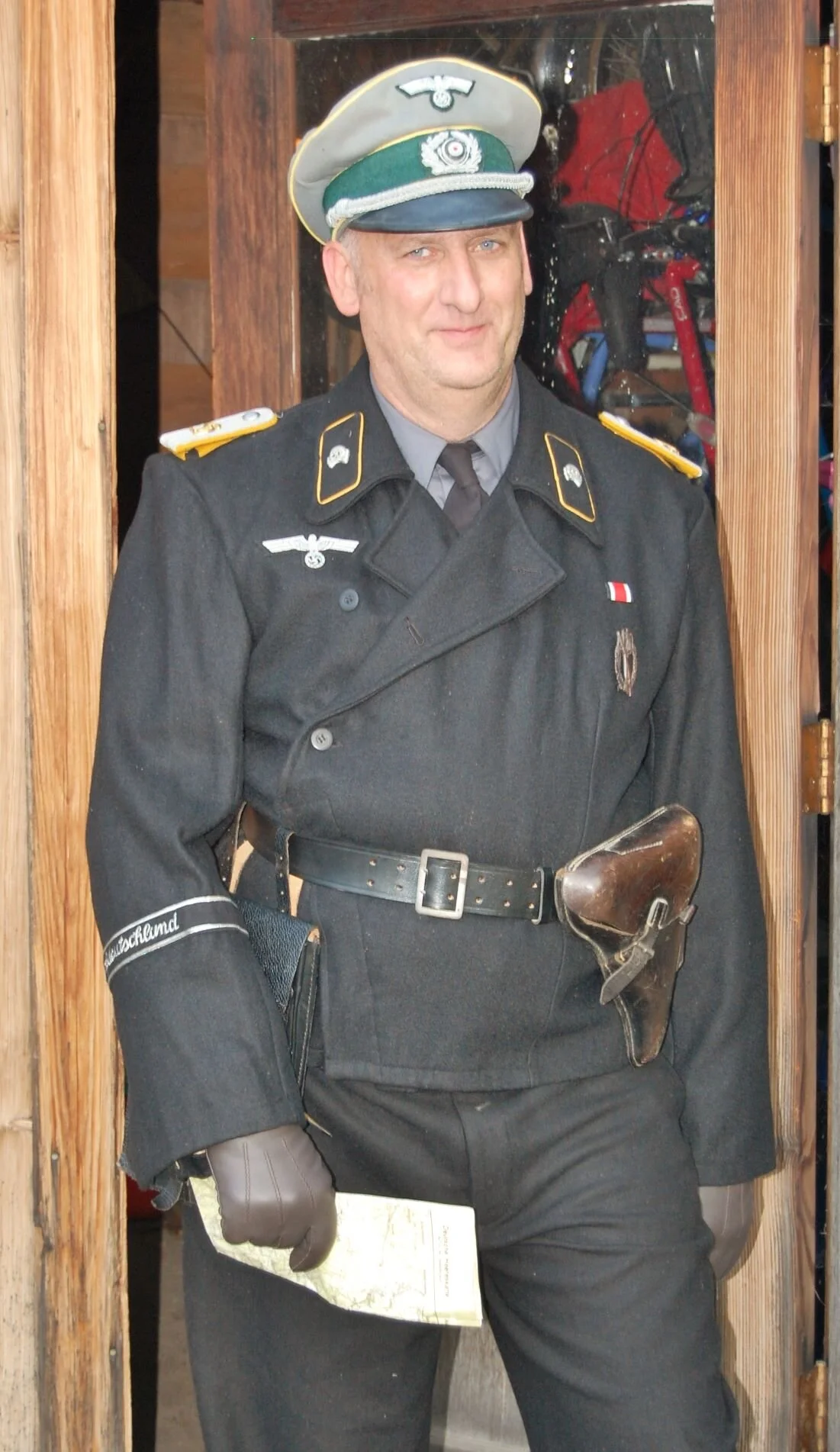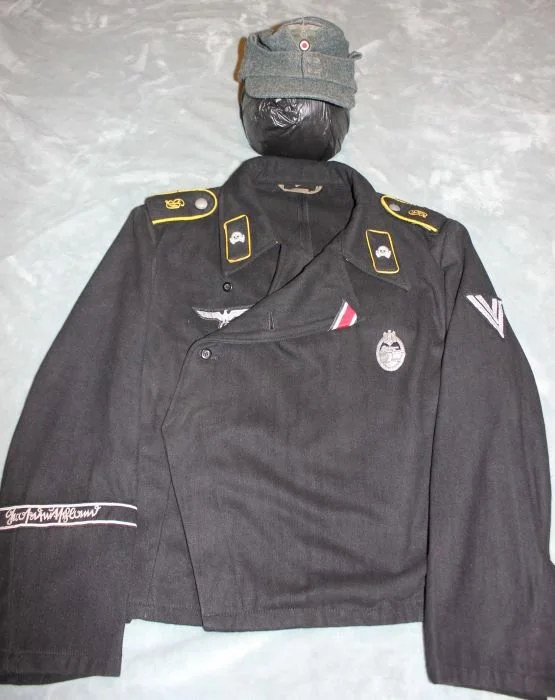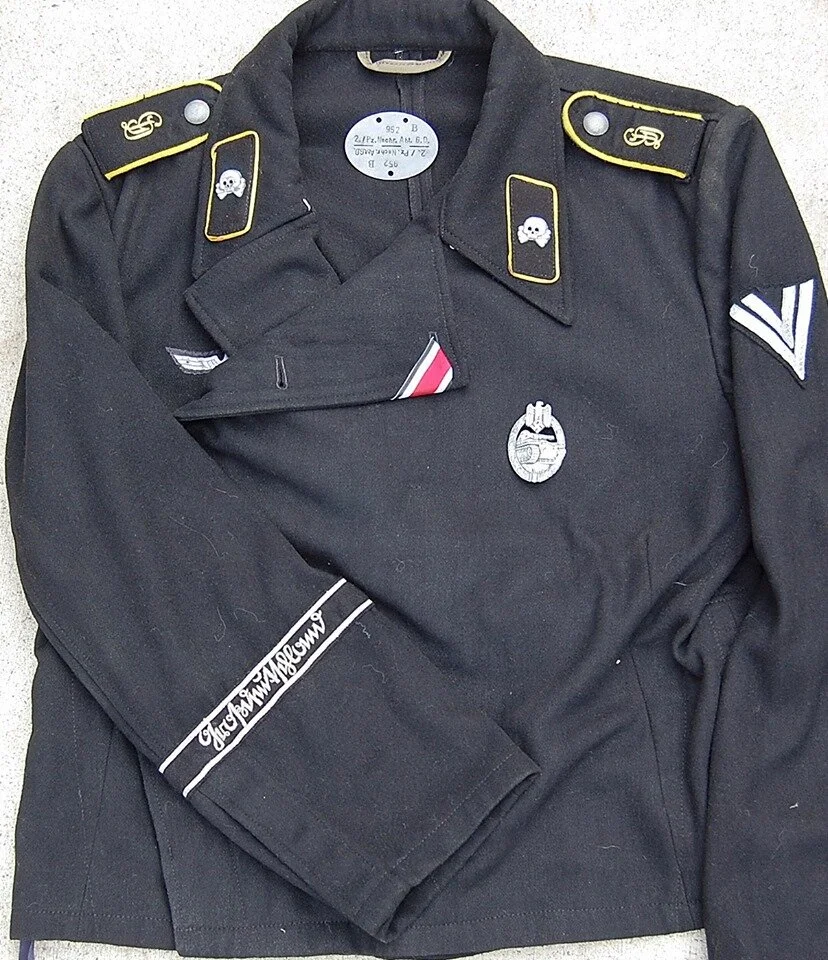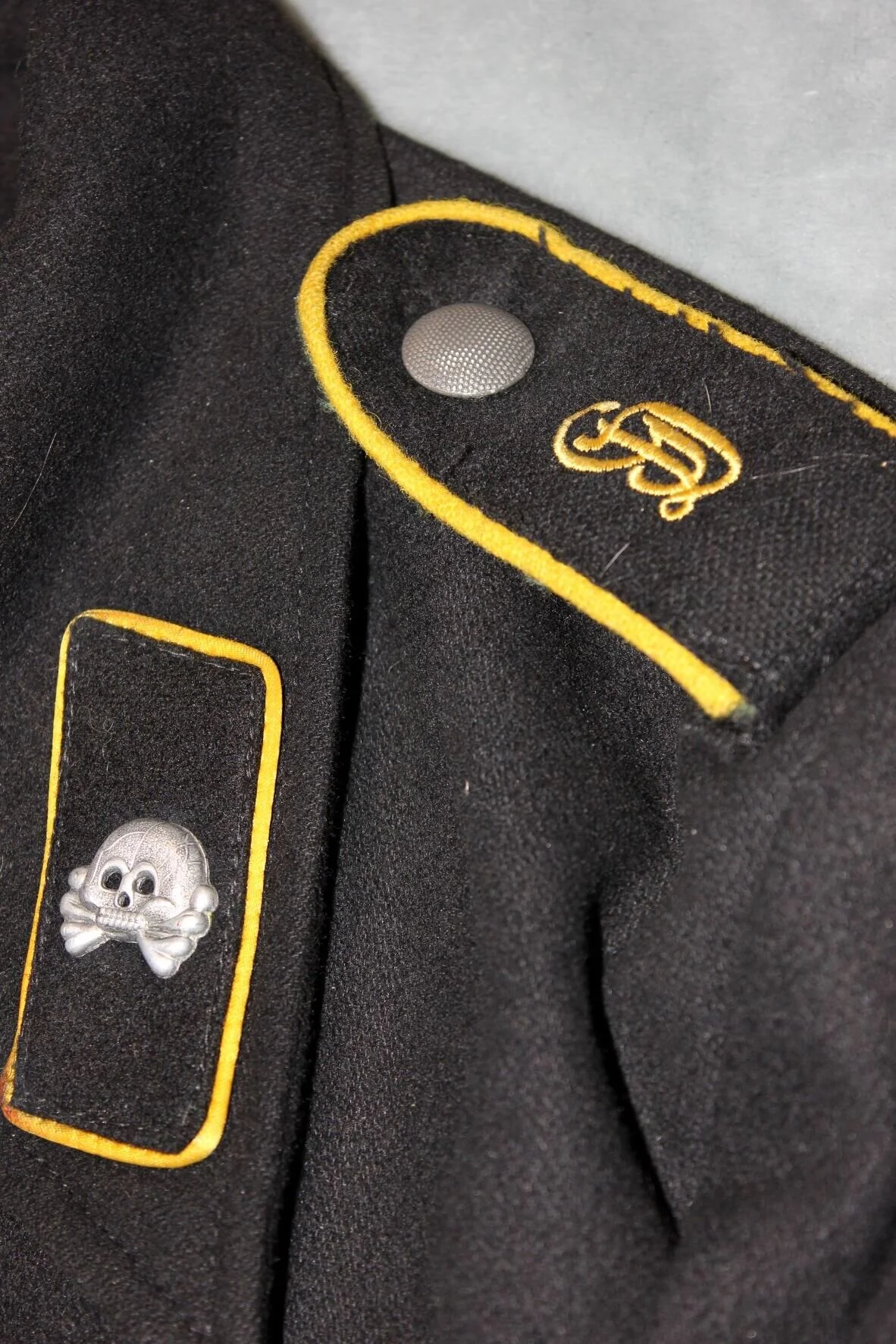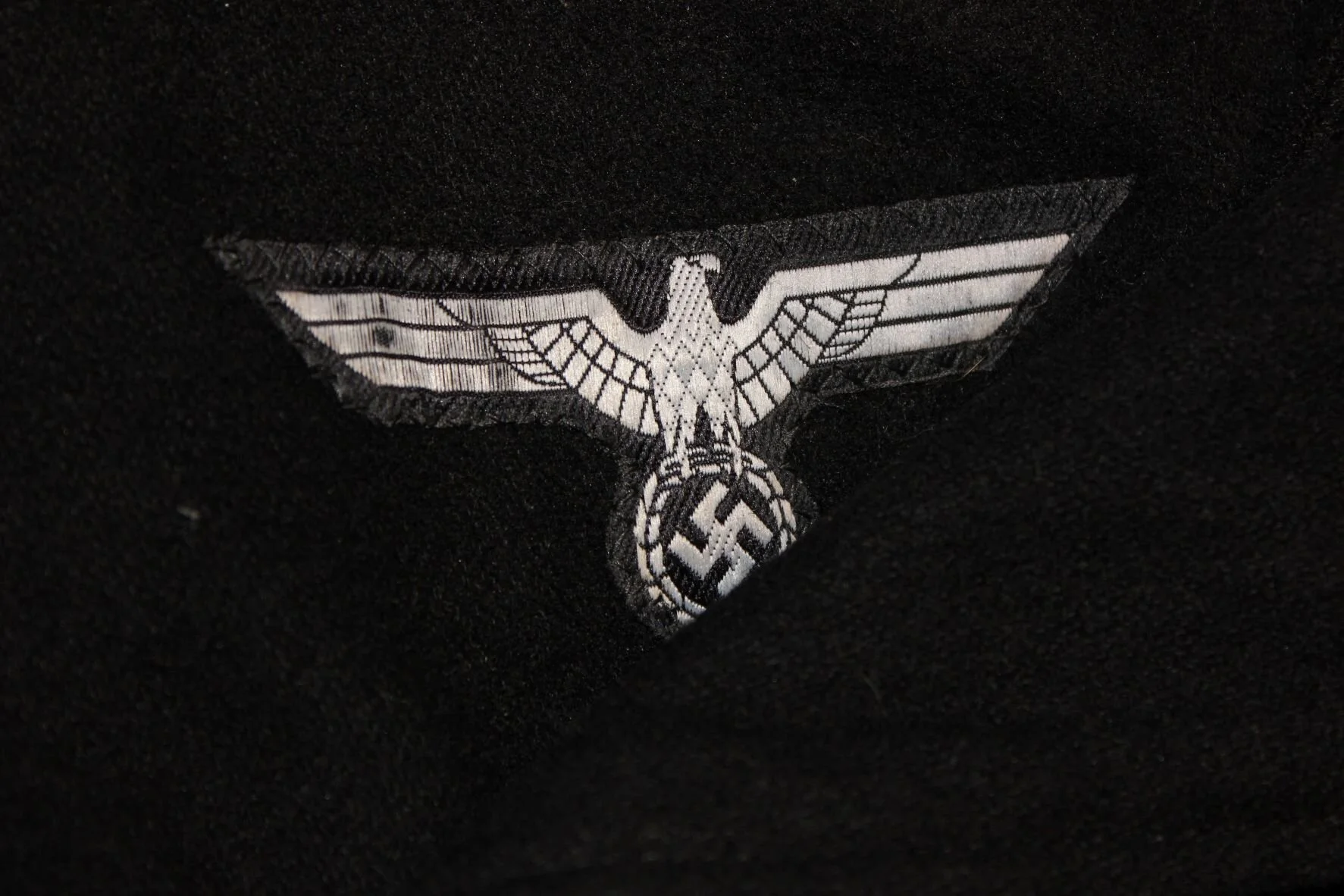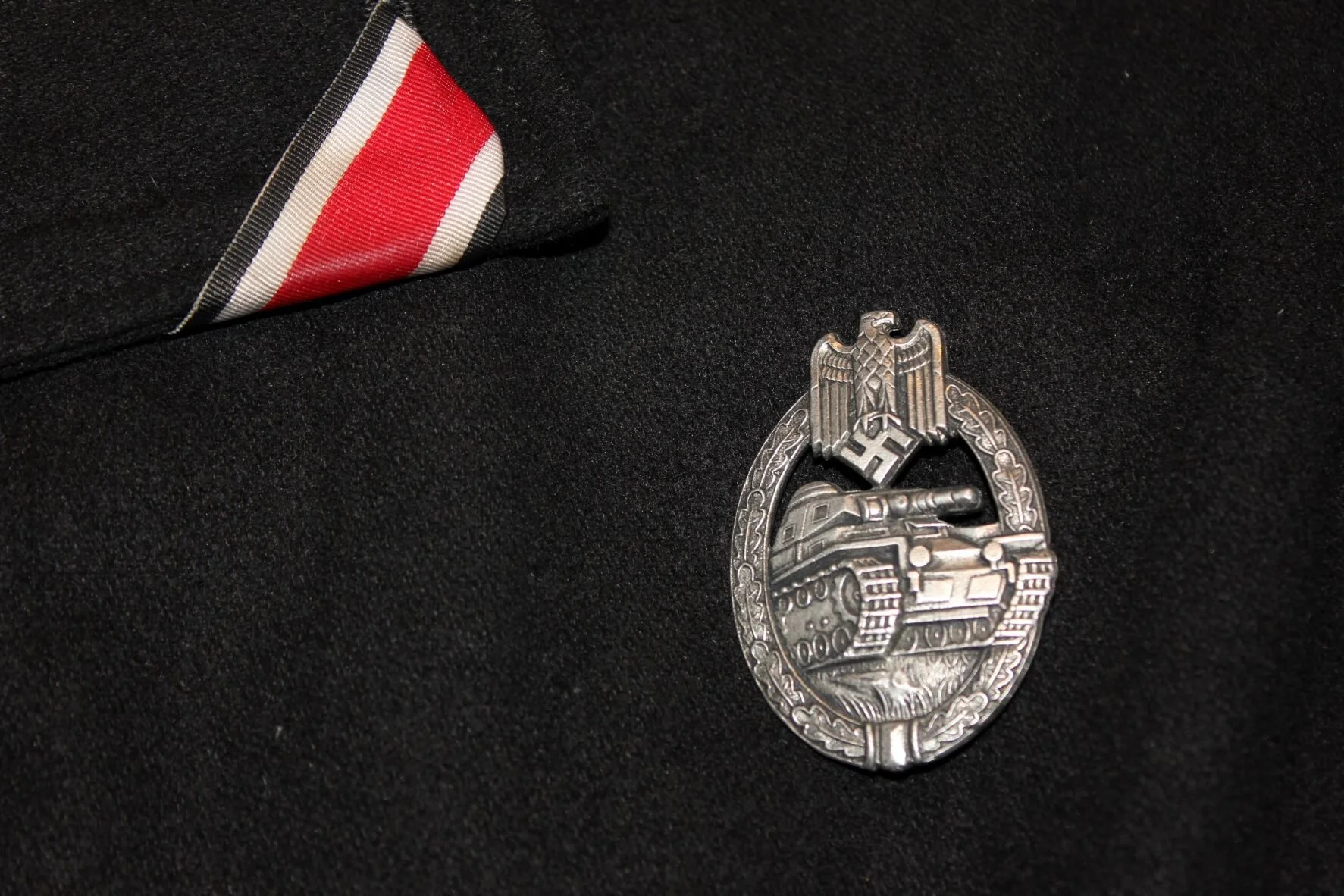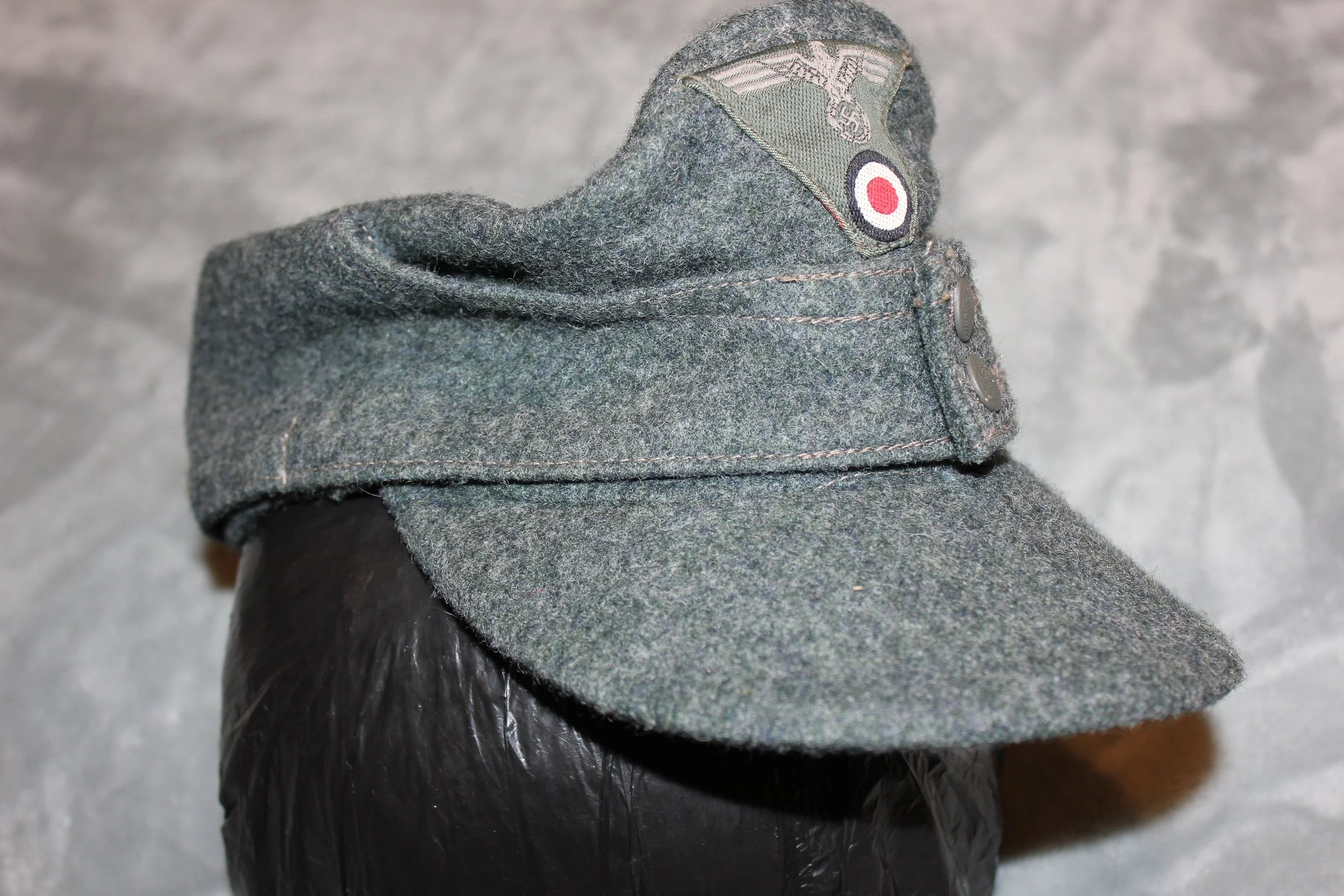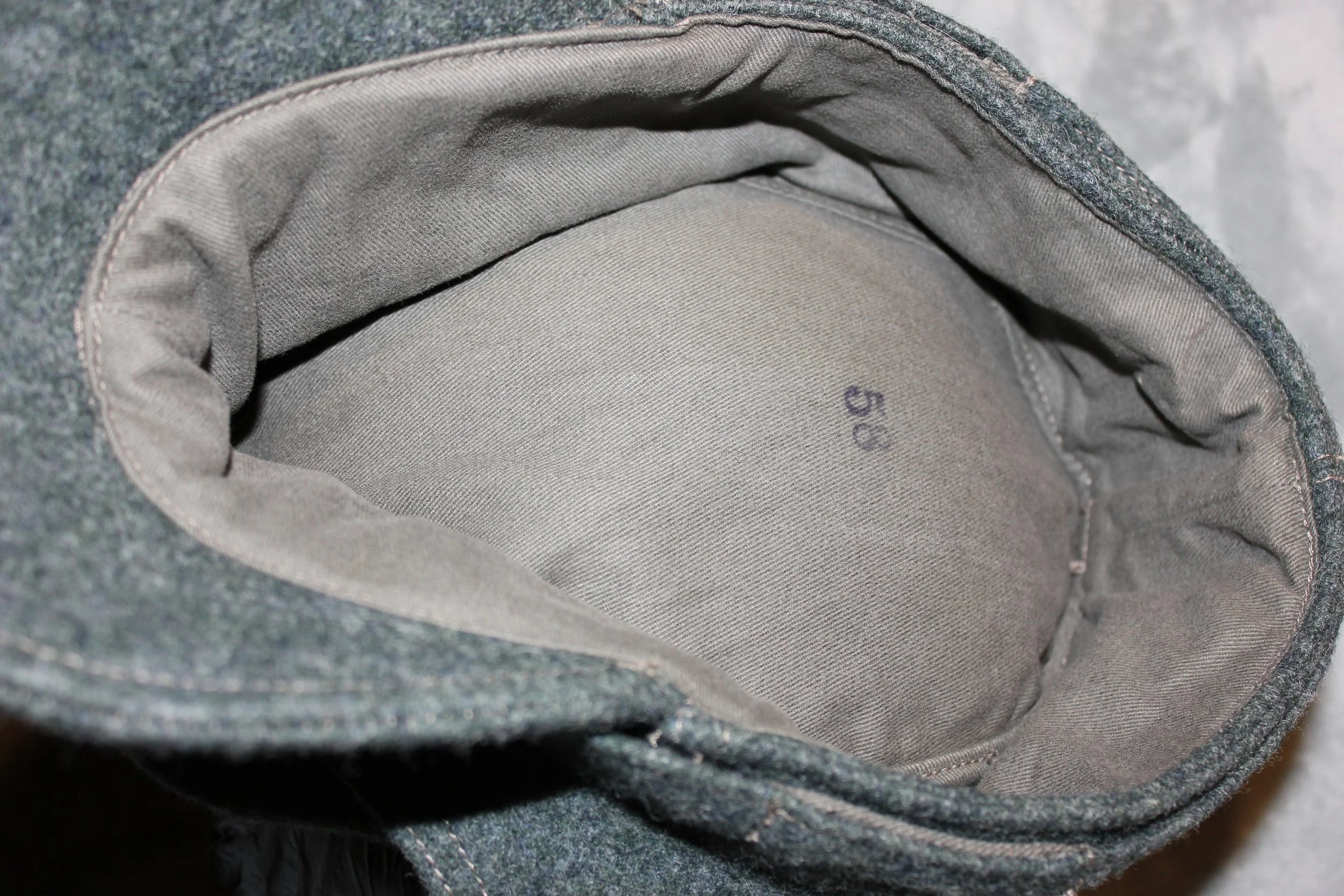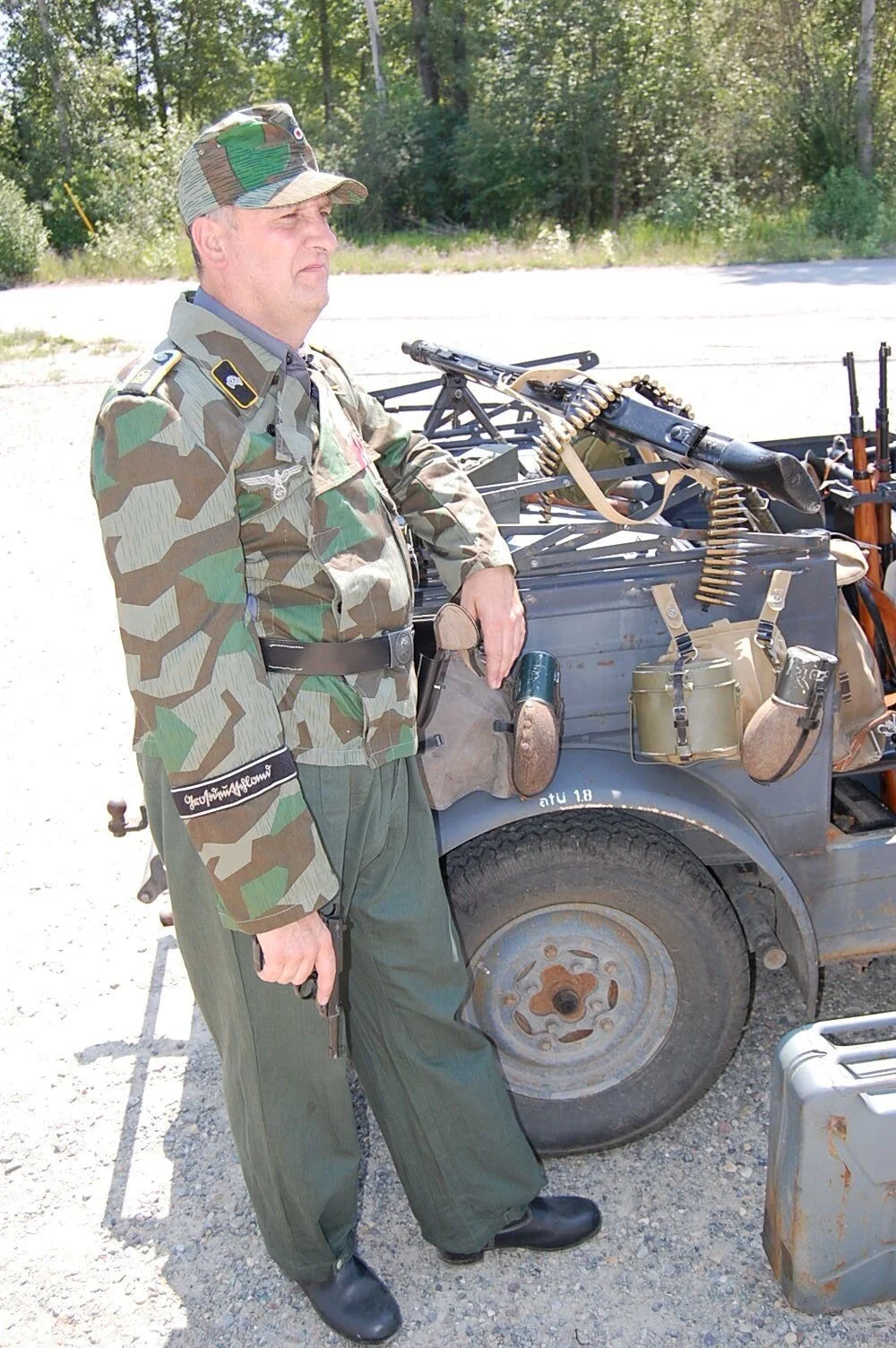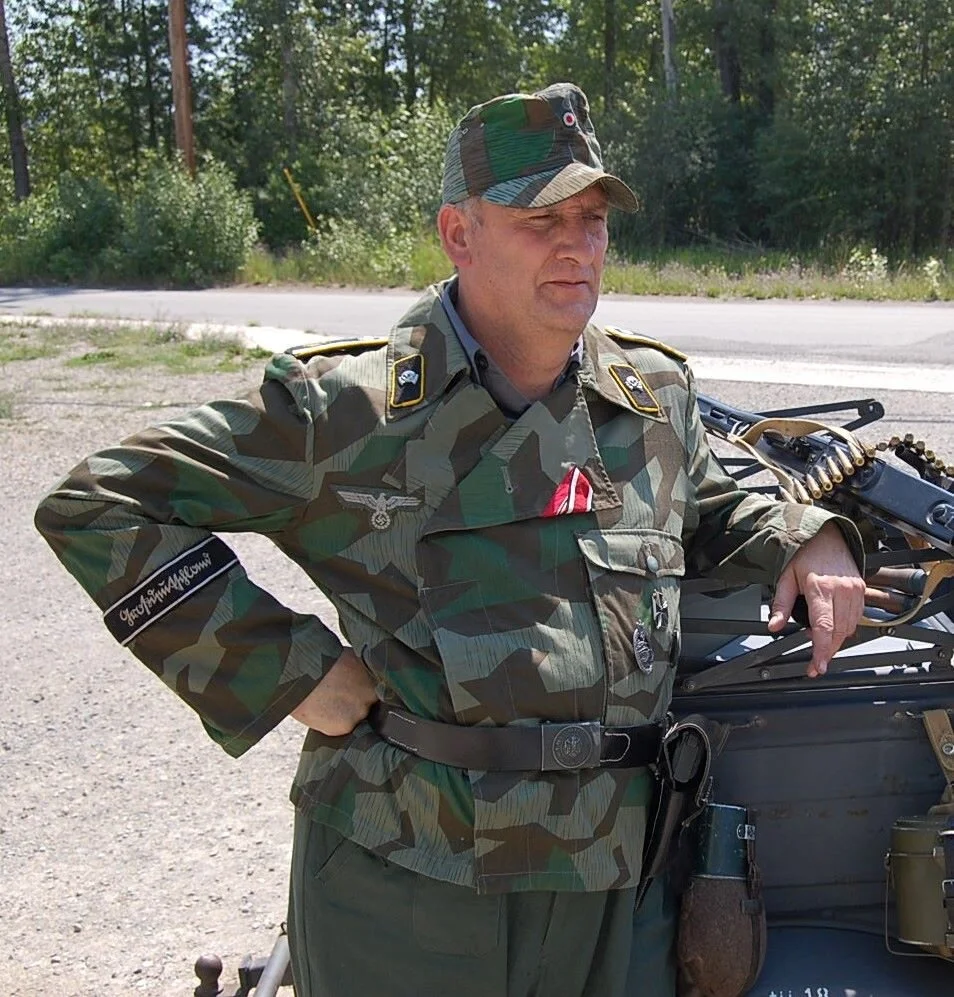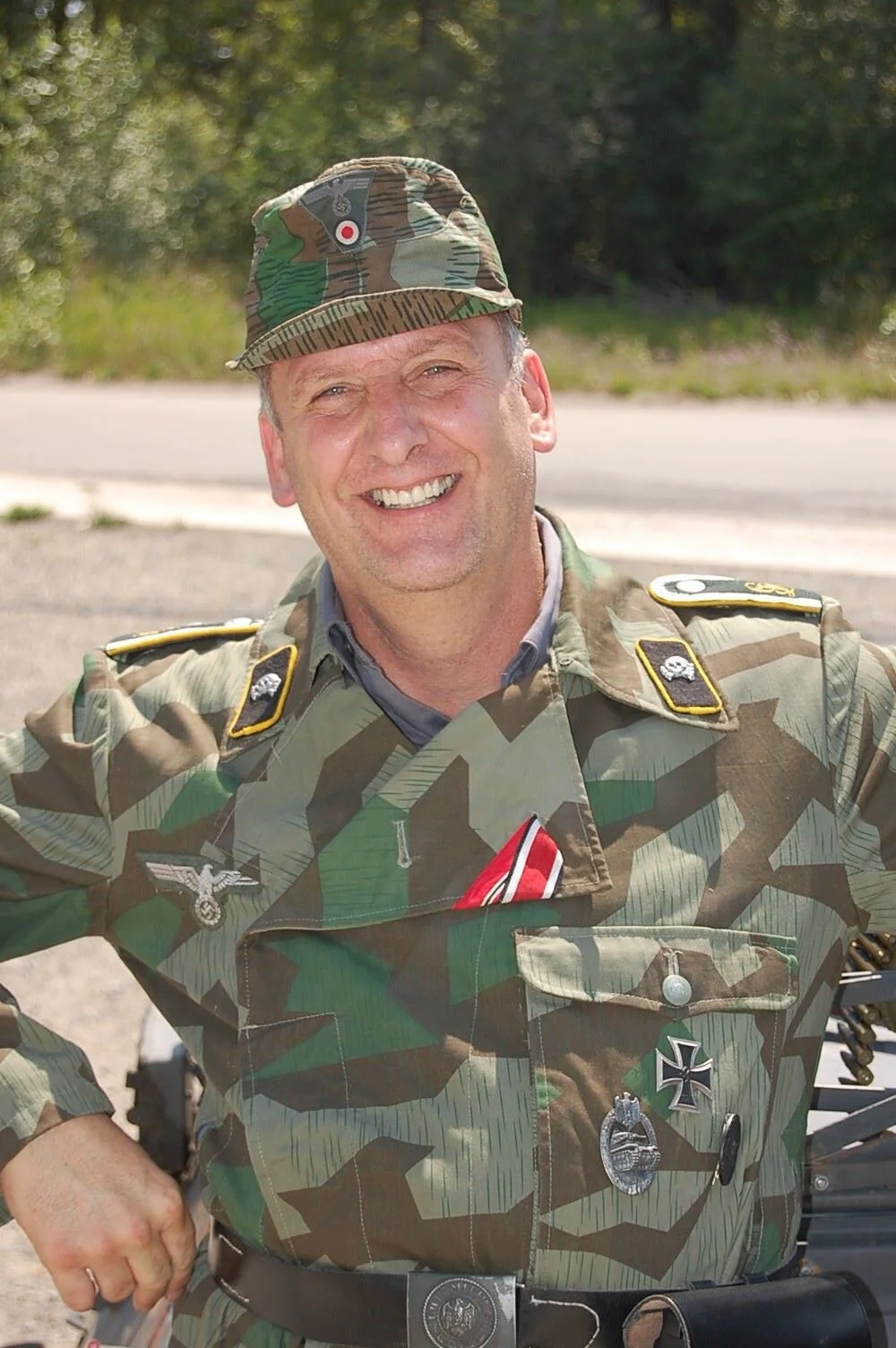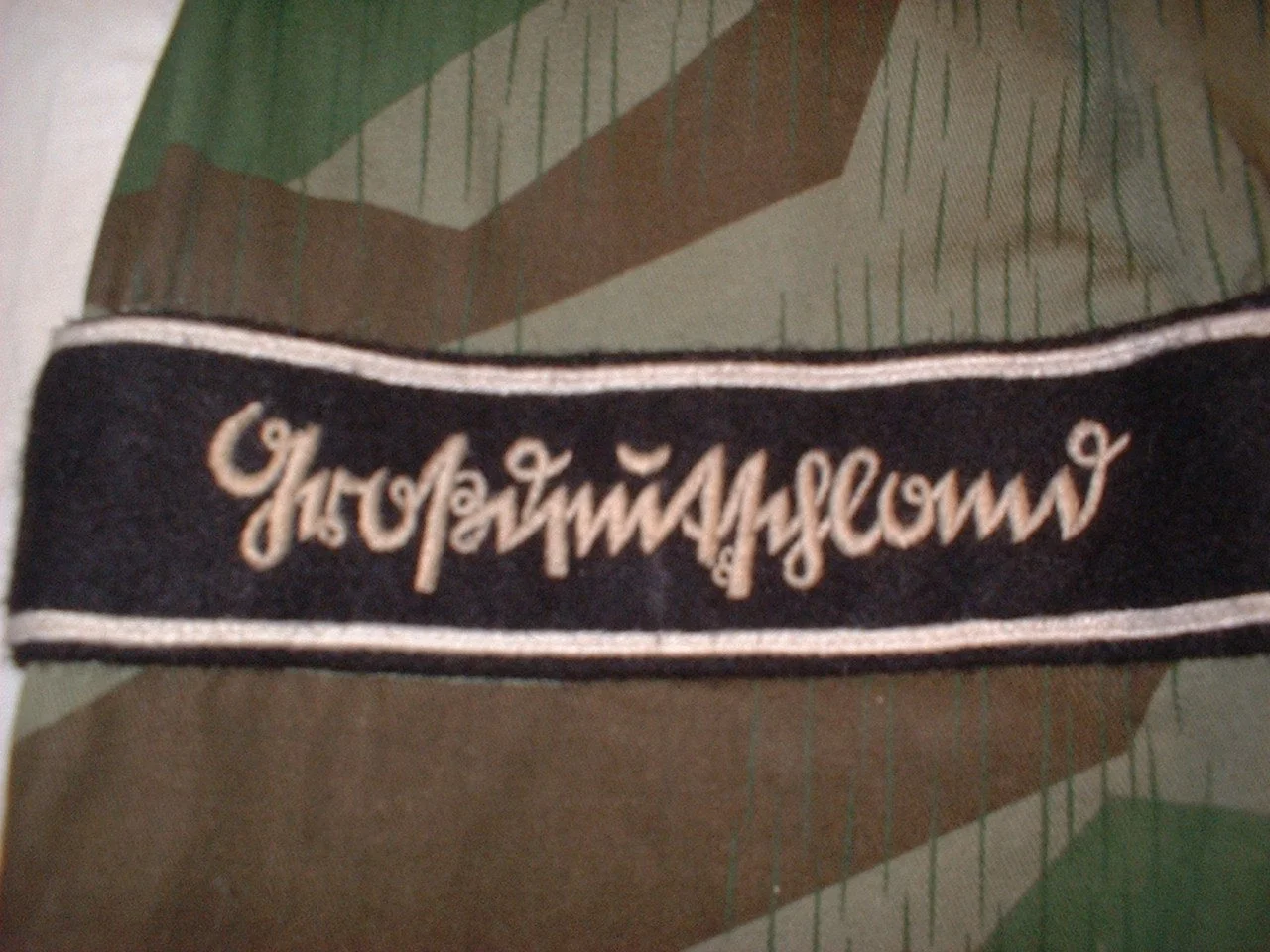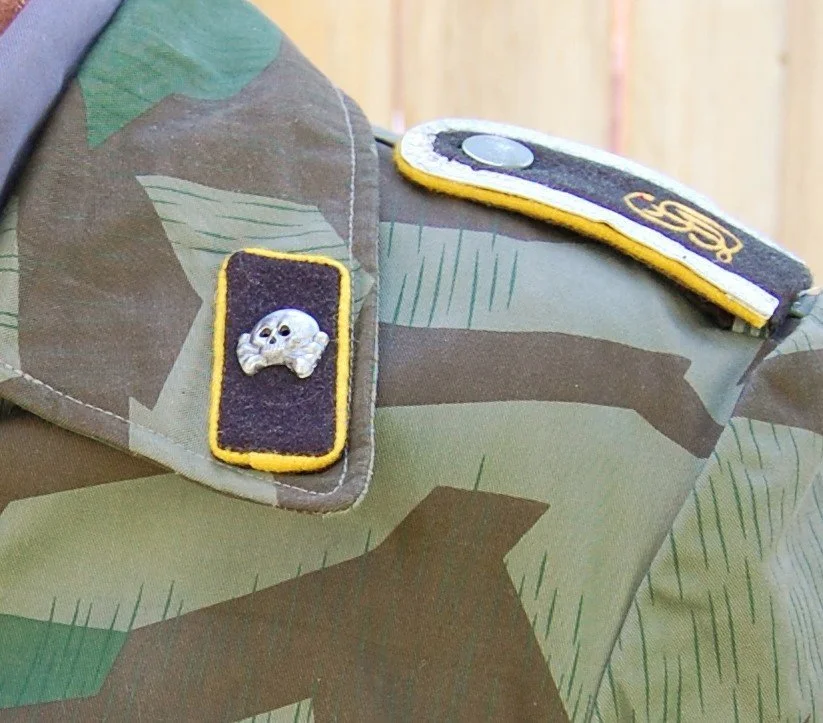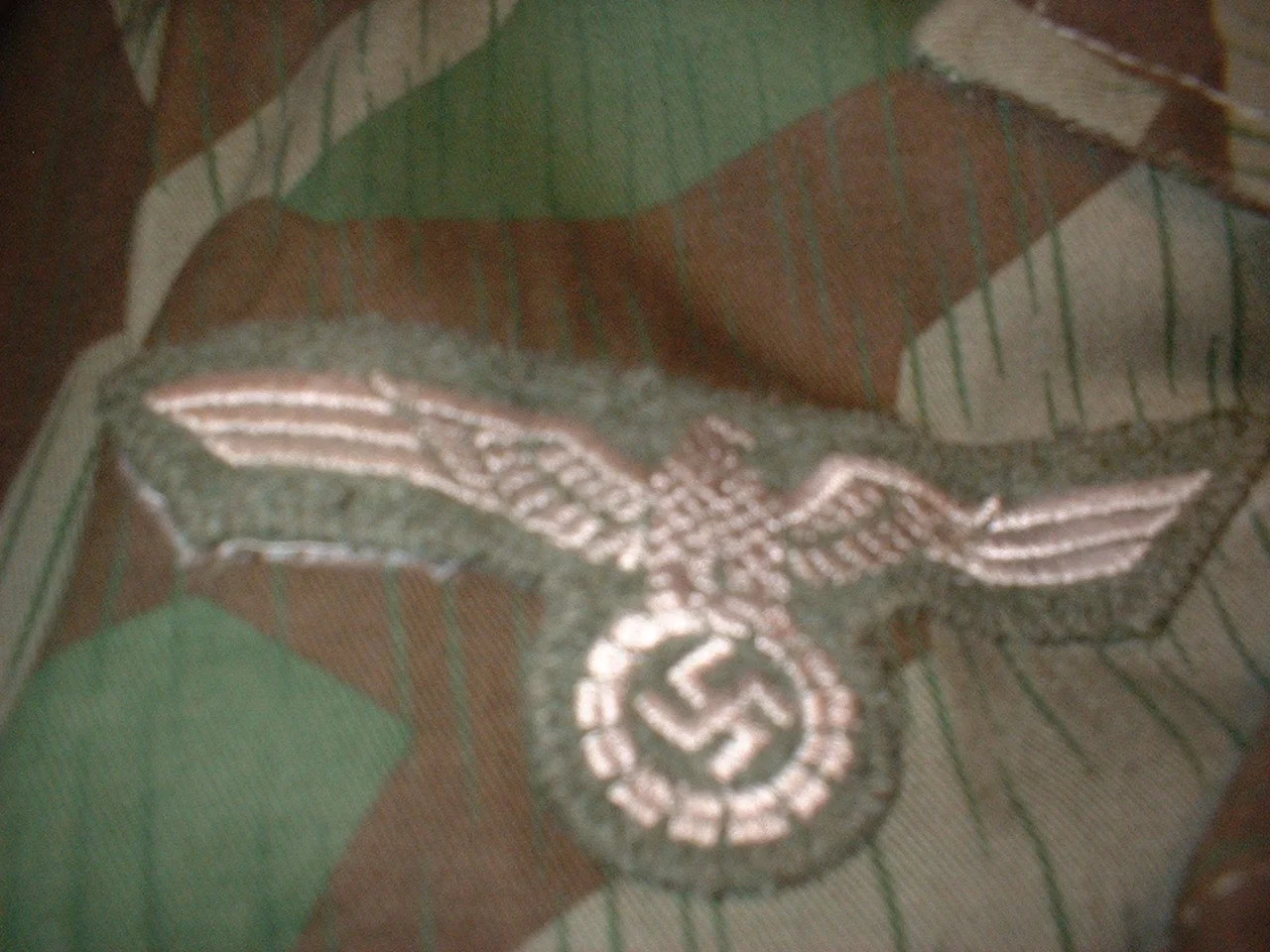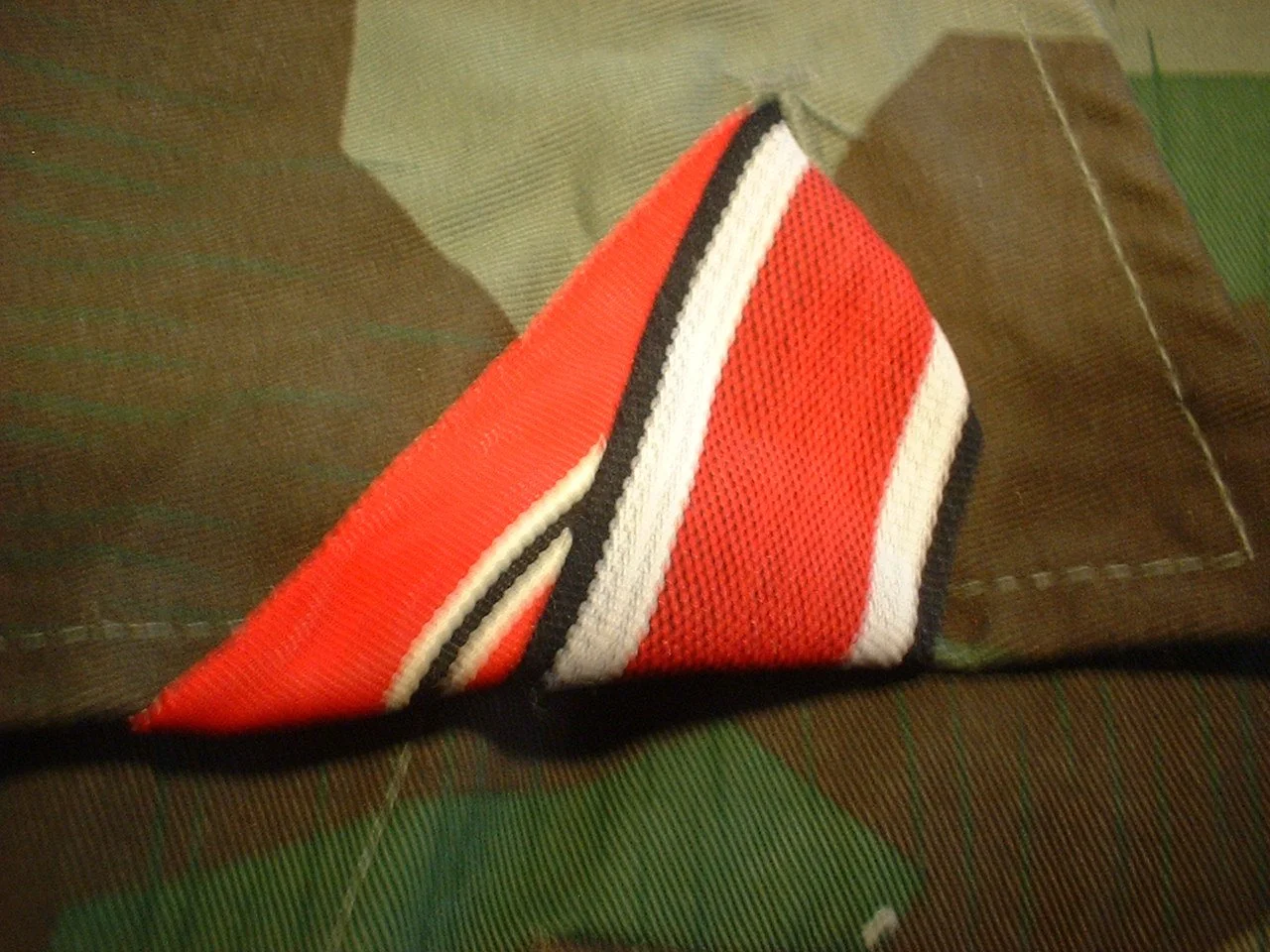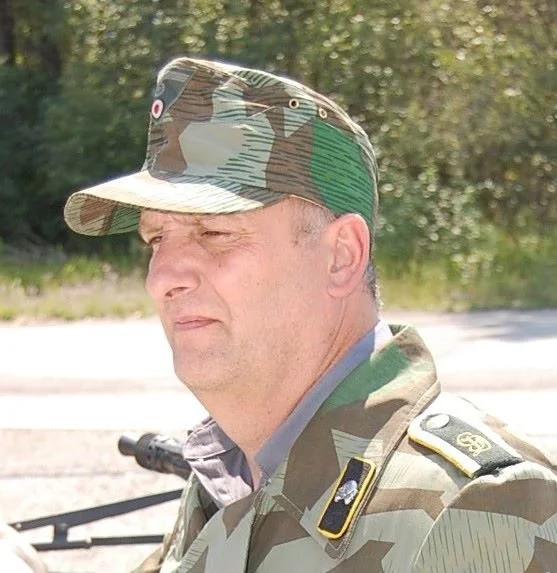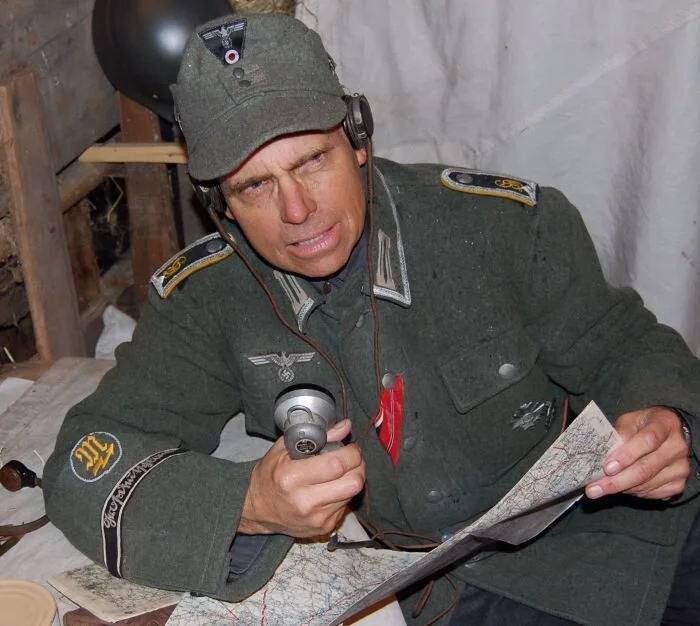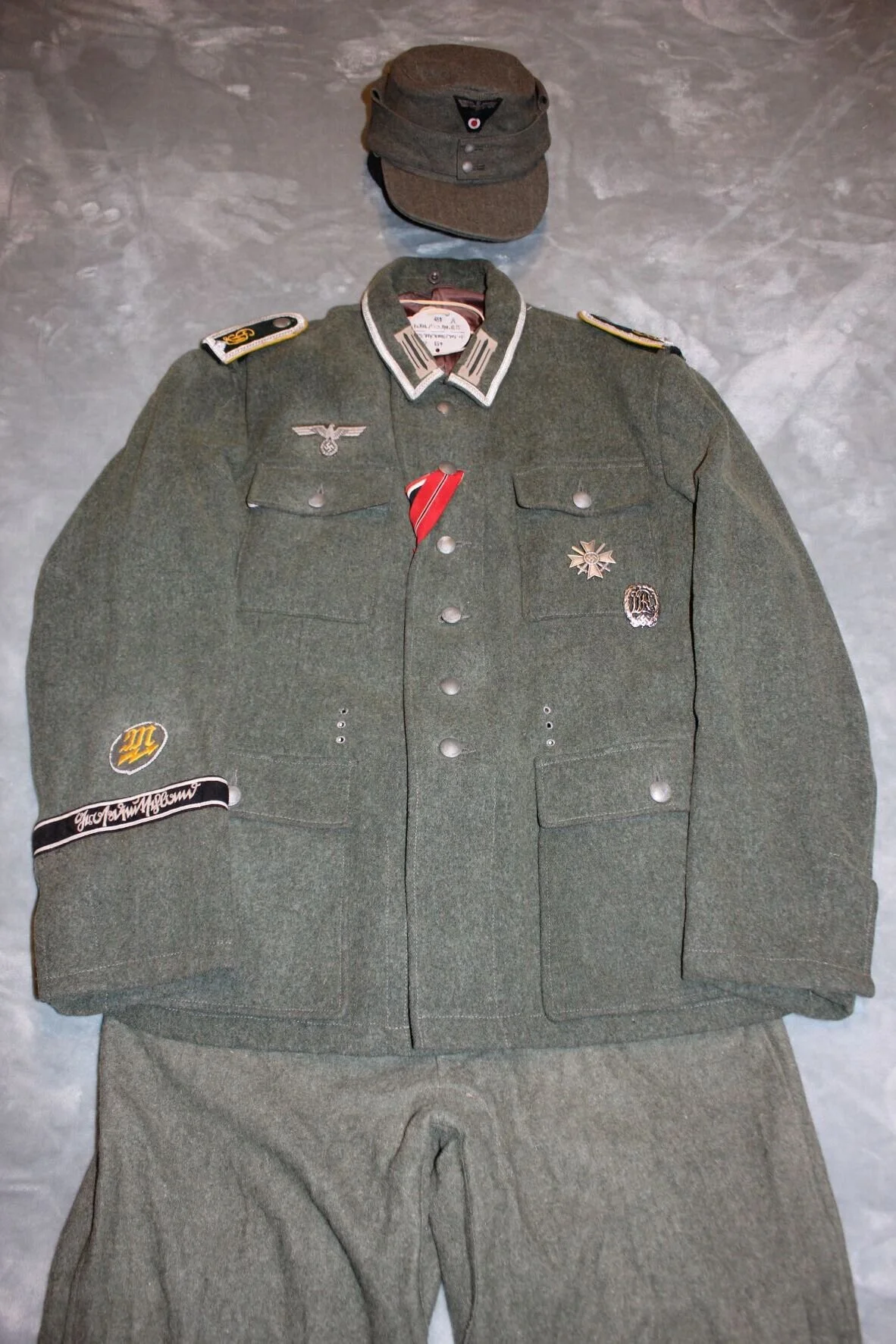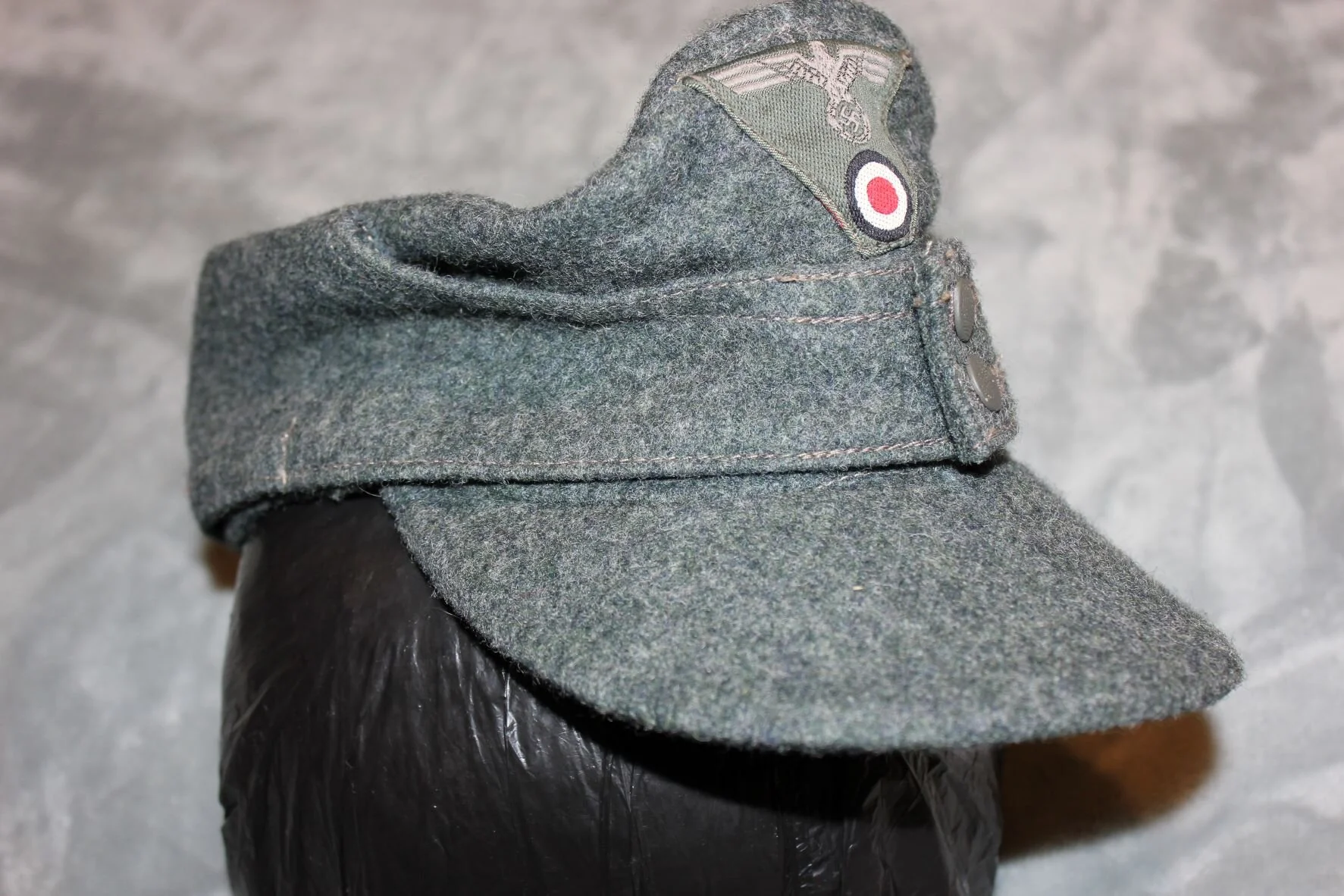Grossdeutschland, Panzer, Assault Gun, Artillery, Recon, & Signals:
Enlisted Man, 'GD' Panzer Crewman, Gray Shirt:
This shirt is shown because it was a common situation with the Panzertruppen, as with all soldiers deployed in warm climates or during hot days, the jackets come off, and the troops are left just in their shirt sleeves. This gray shirt was typically used under the black Panzer Uniform and the Self-Propelled units of the Panzerwaffe. It became common, and they sewed their ranks and National insignia to these shirts because they were wearing them day in and day out, it was summer or hot conditions, in hot vehicles, and they were not wearing their jackets. There was a light feldgrau dyed shirt later on, and some different materials were used in these shirts for warm and cold weather.
The Headphone/Mic picture is of a set that is not one of the sets in my collection, the picture of the internet, as the three other guys in the shirt, and on that note, I, therefore, do not know where to give the correct credits. With the following uniforms, I’ll try to depict the battle uniforms of Grossdeutschland and some of their story, as best I can with what I have here.
Decorated Panzer Driver, Oberfeldwebel ‘Ernst Bartz’, a Veteran of Legion Condor :
On the 23rd of September 1936, Wilhelm Ritter von Thoma was ordered by the Army High Command to Spain as Commander of Group "Imker" (Beekeeper), the ground contingent of the German Legion Condor. Arriving in Spain in early October 1936, the personnel of Group "Imker", who were originally volunteers from Panzer Regiment 6 "Neuruppin" of the 3rd Panzer Division, were tasked with the training of Franco's Spanish Nationalist officers and men in tanks, infantry tactics, artillery, and signals employment. Group "Imker" maintained two, then three Panzer training companies equipped with Panzer I light tanks under the codename group "Drohne" (Drones).
These “Volunteers” were encouraged to go, to learn “Real War” situations, and solutions, and the Germans wanted to see how their new Panzers would fare in battle, and to see what logical modifications might be observed. And they did just that; some came home and went right to work with the “New” Panzerkorps, which the Germans were developing in secret.
Thoma’s vehicle was driven by and maintained by Unteroffizier Ernst Bartz. Bartz was awarded the Condor Legion Panzer Badge, Spanish Cross in Gold with Swords, the Spanish Campaign, and the War Cross (La Medalla de la Campana) for his service in Spain. The Spanish Cross in Gold with Swords was awarded to a soldier who showed great merits in combat or achieved uncanny accomplishments., 1126 gold crosses were awarded.
After the Spanish Campaign, Unteroffizier Bartz was assigned to 2. Kompanie / Panzer-Regiment 3, which was part of the 2nd Panzer Division, where he was awarded the Panzerkampfabzeichen in Silber in 1940. Bartz was transferred to the 11. Kompanie Panzer Regiment “Grossdeutschland” before the fall of 1943. While with the “GD” he was wounded, and received the Verwundetenabzeichen in Swartz in October, and the “Panzerkampfabzeichen in Silber II stufe” for over 25 combat actions.
This Panzerman is a veteran of long proportions! With service dating to the infancy of the armored corps, he fought in Spain as part of the Condor Legion. Returning to Germany, he put on the black armored uniform with the traditional jawless Hussar skulls of the days of Prussian glory. He found a home in the armored reconnaissance Abteilung of the Infantry Regiment. "Grossdeutschland" as part of the Berlin guard troop and then, in the fighting in Poland, France, and Russia. He retains the veteran piped collar as well as his gunnery lanyard from the days when he was the aim that the enemy feared. Wounded multiple times now in 1944, he is a leader, molding new tank soldiers for the division on the training grounds.
The eager youth knows his awards, which include the 50 Tank Assault Award, which few live to receive, make him stand out. His Iron Crosses speak as loudly to his leadership and courage under fire as does his Ost Front Award. The Silver Wound Badge shows he has paid a price for the Fatherland that few can envy. He wears the traditional overseas cap in black along with black wool trousers bloused on his boots.
Note: "Legion Condor" Tank Battle Badge (Panzerkampfabzeichen der Legion Condor). For members serving with “Von Thoma” Members, the panzer group received the “Legion Condor Tank Battle Badge” for their participation, thus making the Legion Condor Tank Battle Badge the first award issued in a time of war by the Nazis.
Note: Inside the Beret is the Order of Military Merit (Red - combatant), and the Spanish Civil War Campaign Medal (Spanischen Freiheitskampf Feldzugsmedaille) (1936 - 1939) over the Spanish War Cross - Breast Star instituted on January 26, 1937.
Unterfeldwebel, Panzer-Gunner and a Condor Veteran, now with “Grossdeutschland” Panzer Regiment:
Unteroffizier Panzer Division "GroBdeutschland" Formed as a Panzer Division in May 1942, the division had already served on all fronts as a Motorized Infantry Division. Fighting continually on the Eastern Front, the division ended the war in Mernel and Northern Germany.
This Unteroffizier wears a Black panzer top with insignia and awards attached. I call this uniform “The Old-Timer” not because of his rank, but because he has experienced a lot of action. His combat leadership has been rewarded with the Iron Cross 1 and 2nd Class. A veteran of the first winter in Russia, he has been awarded the Ost Front Medal, shown by the ribbon in the buttonhole. He has the “Tanker” Award given to him by the Spanish, along with a ribbon for the effort, on the ribbon bar, which holds the Sudetenland ribbon as well. He has the very rare “25 Engagements” Panzer Assault Badge, and the Wound Badge in Silver (probably earned in Spain, the Sudetenland, or France, and Russia (Silver up to 5 times to the hospital). And he now finds himself back in Russia, and finds the resistance far more overwhelming than on the first tour.
Leutnant, 9./Panzer-Regiment Großdeutschland :
On 19 May 1943, with the addition of “Panzergrenadiers” now riding in armored personnel carriers and a Kompanie of Tiger I tanks, they had become the Panzergrenadier Division “Großdeutschland”. The newly re-equipped division was subordinated to the XXXXVIII Panzerkorps, part of IV Panzerarmee, and took part in the Battle of Kursk. After the Kursk offensive was canceled, the division was transferred back to Heeresgruppe Mitte and resumed its role as a mobile reserve. The Tiger I Kompanie was expanded to Bataillon strength, becoming the III. Bataillon of the Panzer-Regiment. Großdeutschland and saw heavy fighting around Karachev before being transferred back to XLVIII Panzerkorps in late August.
The Leutnant wears the newly developed reed green HBT Panzer “Summer” uniform. He has added a divisional Ärmelstreifen or cuff title along with offizier Schulterklappen u Panzer Litzen. While a veteran, he does not wear any decorations on his Panzerjacke, perhaps yet to come, as this period photo shows the damage to his Tiger following the fighting around Karachev. He wears the Feldmütze für Offizier alternate or ‘Crusher’, along with a civilian scarf.
Unteroffizier, GD. Panzer Crewman in the Splinter Camouflage Wrap:
Formed as a Panzer Division in May 1942, the division had already served on all fronts as a Motorized Infantry Division. Fighting continually on the Eastern Front, the division ended the war in Mernel and Northern Germany. The Armored Anti-Tank Battalion fielded tracked anti-tank guns on which the crews were authorized to wear the special armored uniform. This Unteroffizier wears a custom-made camouflage Panzer Wrap with insignia and awards attached.
Like all armored troops, he wears rose Waffenfarb piped shoulder boards, with even the cipher having the pink color, I do not know of any other Wehrmacht of SS units that used anything but white but he keeps his linage with towed anti-tank gun soldiers, with the use of his standard collar Litzen, As a Panzerjager, he has won the General Assault Badge for over 25 engagements. Wounded at least once qualifies for the Wound Badge in Black. His combat leadership has been rewarded with the Iron Cross 1st and 2nd Class. A veteran of the first winter in Russia, he has been awarded the Ost Front Medal, shown by the ribbon in the buttonhole. When not wearing a helmet, he wears the popular M43 cap and wool trousers.
Unterfeldwebel, 16. Sturmgeschutz Kompany, “Infantry Regiment (mot) Grossdeutschland“:
During the Battle of France, some of the first Sturmgeschutz Armored Vehicles that were used in action were the Sturmartillerie Batterie 640 (attached to IR.GD.) had 6 StuG. III vehicles. After the battle, they became StG. Kp 16. IR (Mot) GD.
Replacing casualties, this NCO had just arrived at the regiment in August 1940 and issued his new (1st pattern) cuff title. The regiment, stationed in Alsace, they were preparing for the invasion of England, but they would soon move over to the Swiss border, as they were slated to invade Gibraltar. His first taste of combat will come late, though, when they cross the Soviet frontier in June of 1941.
His uniform, an extremely rare example of the early war 'version of the feldgrau ‘Assault Vehicle Wrap’, it’s rare in that it has the bottle green collar as seen on the M-36 infantryman’s jacket. The collar retains the standard Artillery ‘Litzen’ collar insignia, red being the color identified with the Artillery branch.
The metal G-D ciphers are identified with senior NCOs of the regiment. The uniform calls for the very rarely seen, or found, early feldgrau Beret / Crash helmet, if not a helmet or the overseas cap, or as in the photos, a crusher cap, for his commanding position in the vehicle. I made the uniform many years back and ordered a nice crash helmet for it, but it just never came, so I never received it, and I got tired of waiting for it. And now looks to be gone forever, I guess these things happen. It would have been awesome to have the uniform. Of course, he would have had matching trousers as well as black leather boots.
Note, the bottom pictures (Off of the internet) show (1) a fellow with a similarly collared jacket, and (2) what soon became the normal Early StuG-Wraps, still carrying the Heer-Litzen on the collar, rather than the popular Panzer ‘Totenkopf’ collar tabs, This continued when the Self-Propelled guns, of the Marder II & III series and the like, ‘open-top’ Assault guns. The final picture of good pictures of the early StuG. IIIs.
Unterwachtmeister, Sturmgeschutz Abteilung:
This was the look the general Sturmgeschutz Crewmen would wear. The insignia piped in Red Waffenfarben of the Artillery branch of the Heer. In the StuG batteries, the Feldwebel was referred to as Wachtmeister. The special uniform of the armored soldiers was cut from the Feldgrau cloth in the identical style by the Panzertruppen. The red piping ran around the Field-Gray panzer-style collar as well as the shoulder insignia.
This example shows what would likely be a newly promoted Unterwachmeister who has added a piece of tress to his existing high-quality dark green backed shoulder boards with the Red “GD” ciphers. His promotion was probably part of the mid-1944 divisional organizational increase, bringing the StuG unit to Brigade size. The Unterwachmeister wore matching armored crew trousers, short black boots, enlisted belt, and holster, along with his Feldmutz, which is also piped in the red Waffenfarbe. He has been awarded the Eisernes Kreuz II. /Klasse as well as the Sturmabzeichen in Silber, and Verwundetenabzeichen in Schwarz. With the third pattern Armelstreifen, this Bluse represents what would be the standard uniform for an NCO of the Sturmgeschütz Abteilung “Grossdeutschland”.
Armored Artillery Gefreiter, "Grossdeutschland" Division Summer 1943:
GroBdeutschland was one of the first Heer Panzer Divisions to have a full complement of tracked armored artillery. This corporal wears the armored-style HBT red-green jacket with normal Feldgrau wool trousers. A veteran of the Russian campaign, this soldier has won the Iron Cross 2nd Class as well as the War-Merit Cross with Swords, along with the General Assault Badge for being in at least three combat actions on separate days.
His rank is shown by the double-striped chevron on his left arm. He wears the Grossdeutschland cuff title in the third pattern on his right cuff as well as ciphered shoulder boards piped in red for artillery. The panzer-style collar insignia is one of several variations used. He has an old-style overseas cap, and the later HBT / M43 style caps, being used.
Hauptmann, Diddo Diddens, 1. Batterie, Sturmgeschütz-Abteilung "Großdeutschland":
Diddo Diddens had his first command as a Leutnant with II. Zug II StuG. Abt. 185 on the Eastern Front. During the bitter Winter Campaign, his Sturmgeschütz destroyed 35 Soviet Tanks. In March 1942, he was awarded the Ritterkreuz des Eisernen Kreuzes. In the Spring of 1942, Diddens was transferred to the Sturmgeschütz-Abteilung of the Infanterie-Regiment “Grossdeutschland”. And soon again, Diddens had earned a reputation as a skillful tank hunter.
In April 1944, Diddens took command of 1./StuG. Abt. “GD” was involved in heavy fighting for Romania. Supporting attacks by II and III. Panzer Grenadier Regiment “Grossdeutschland” in the woods between Barbaetsi and Vascani, north of Targul-Frumos, Didden’s 1./ Batterie knocked out 23 anti-tank guns, and when confronted by a large number of Soviet tanks, forming up in an assembly area, Didden, while making a tactical withdrawal, destroyed further anti-tank guns and 3 tanks, earning himself a mention in the Wehrmachtbericht on 27 April 1944. During early May, Diddens continued to distinguish himself, but unselfishly and charismatically declaring every man in his unit had also earned the same recognition as he did, and in so doing had all their names mentioned in the Wehrmachtbericht or “Order of the Day”.
23 May saw elements of StuG. Abt. “GD” pounded, north of Zahorna, by renewed Soviet tank attacks supported by Il-2 Stumoviks, to which Diddo’s batteries moved to counter-attack and retake Zahorna. A decisive counterattack by the Soviets thwarted the assault, and in the process, Didden was seriously wounded. Didden’s hovered near death, having lost a leg, and while still in serious condition, was awarded the Eichenlaub or Oak Leaf to the Knight’s Cross on 15 June. In October 1944, Didden was promoted to Captain of the reserve. he served the remainder of the war in a local defense area near Bunderhammrich in Ost Friesland. Diddo Didden survived the war and lived a peaceful life till he passed away 27th of September 1997.
Before entering service for the Heer, Didden had been an Unterscharführer in the Allgemeine-SS. Upon winning his Ritterkreuz, Reichsführer Himmler ordered Didden an honorary promotion to the rank of SS-Reserve-Untersturmführer and awarded him his SS-Ehrenring (and seen in photographs of Didden while with his StuG, with the “GD”). Himmler used the ring as a personal award for bravery and leadership, given to SS men in leadership positions.
The uniform would fit as Diddens had a pretty much standard issue, an M36 officers’ uniform, while leading his StuG. group, he wore the standard Feldgrau, wool special wrap. His Red-Piped Crusher with BEVO insignia on it is not with the uniform at the moment, the picture of the cap here by itself is an extra cap I found in the uniform storage, but it’s a nicer Officers-Quality Crusher made from a nice cap.
Obergefreiter, 18.Kp. (sf.) Panzerfusilier - Regiment “GD”:
In the Spring of 1942, “Marder” Self-Propelled Anti-Tank Guns were implemented into the Panzerjager Abteilung Grossdeutschland as well as the 1st Zug of the 18th Kompanie of both the Grenadier Regiments. The general fielding of these weapons began in 1940, and crews were issued the black “Special Panzer Wrap” uniform. While the Grossdeutschland only had towed Ante-Tank Guns, until 1942, photos show Pak (Anti-Tank) Crewmen wearing the Feldgrau version of the panzer uniform before Operation Barbarossa.
With the increased amount of photographic evidence that constantly appears in publications, it can be said that the men of the “GD” took some liberties with their uniforms and insignia to make their group identifiable. The unique adaptation of the “SS” style use of the (Schirmmutz Cap Insignia) Metal-Totenkopf device, being used by this Zug, with the addition of rose color cloth backing behind the eyes, produced the desired effect for them, and they were quickly identifiable for their affiliation.
The “Panzerjager” Units of the “GD” were constantly in the fray and suffered numerous losses. Often battle swung in the tide of German forces through their sacrifices. Perhaps this dedication was what led to their kammraden keeping their regulations at bay for this Zug. This Obergefreiter wears the modified Panzer Jacket with matching trousers (I have photographs wearing the Green HBT as well), an issued gray shirt, and a black tie.
He has affected a unique look to his private purchase Schirmmutz by applying an SS-style cap eagle; perhaps it was a Zug change. With this, he wears the Heer buckle and belt. He wears the East Front ribbon (a symbol of the first winter of the war in Russia). He won decorations for combat leadership too, having earned the Iron Kross 2nd Class, and he has been wounded at least once, having the Wound Badge. In control of the 3rd Marder in the Zug, he has engaged the enemy 3 times, most likely many more than that, but this is what you received, the “Sturmabzeichen”, late in the war, 25, 50, and 75 were to be issued, but few ever made it to the troops who deserved them.
Panzervorhandunteroffizier, Werkstatt-Kompanie, Panzer Regiment “Grossdeutschland”:
As the German Army fielded new vehicles of all sorts to fill the ranks fighting in Russia and in Africa, and with the complexity of all the different types of vehicles, the ability to keep the vehicles on the front line increased. And then with the fielding of the new “High Tech” Panthers and Tiger Tanks, to all the ground forces, Heer, Waffen-SS, and Luftwaffe made delivery of new vehicles, and spare parts, never on hand, all on back order, and unable to keep with the back and forth movements of the front lines, was quite a challenge for the maintenance people.
By 1943, the technical aspects of the Panzers had gotten so great that a special technical ranking for tank mechanics, the Master Armored Technician Artisan, was introduced. Created in four grades, each with a special insignia. The word went out, like Doctors and Nurses, Mechanics, and experts in particular vehicles were in big demand throughout the war.
The Military desperately needed technicians with the savvy to fix these precious vehicles, and with the various new equipment, trained expertise in mechanical and technical fields was needed on all fronts. A task that was made even more serious when you realize a good portion of the German equipment in use was in the form of captured vehicles, of which there were no spare parts, and most often left on the side of the road if they broke down, there was just no way they could be fixed in any reasonable time.
Every Panzer that broke down or was knocked ”out of commission” was a lost asset the Germans could not afford to lose. The unsung heroes of the Panzer regiment were the recovery and maintenance men who had to go out and find the damaged vehicles, and either get them running in place or tow them to a place away from the battle line where they could do more serious work on the vehicles, like a temporary or mobile workshop, often doing this under fire and at night.
This was followed by a Panzervorhandwerker who did a triangle of assessing the damage, deciding what was needed to get it back out and on the front lines, and then placing it in the workshop, with a team to do the project. One can imagine that many were hit by enemy fire that penetrated the hull or turret, thus killing anyone in the vehicle most horrendously, blown to bits, and quite a mess, then, upon the ammunition and fuel brewing up, burnt everything inside to a crisp. But some were repairable, so desperately needed. This often led to the newest in the group having to wash the smoke and blood out of the vehicles, and clean out the bits and pieces of “human remains”. Then the project would begin.
The hole from the knock-out round would be patched, and the rest of the vehicle brought up to par, working and running (Sometimes the inside might be repainted), but rushed back to the battle as soon as they could. Still, the Allies made tanks and delivered them to the front in such numbers that this would never be enough to change the inevitable outcome of the war. The German tanks were never designed for the practicality and ease of maintenance; more mass production, being much more complicated, and with fewer workers in the plants, they could not out-produce the Allied forces. Between Russia and the USA, it must have been 50 to 1 in tank production.
Often, the repairs on German vehicles were difficult, with it seeming little thought given to maintenance in the field. There was a towed overhead crane developed for the removal of the turret, for instance, the transmissions generally required the top or complete removal of the upper superstructure, very impractical. There were truck-mounted cranes to pull out the engines, transmissions, etc. Most often, this work was outside in the elements, and with little light or heat. One should mention the US forces, and the English were far ahead of the Germans in this situation, but the Russians were far less efficient, I think, during the war, and equipment was considered more often than not, disposable. The German specialists and mechanics often ended up coming from the factory, and they were a determined and dedicated lot. But if they were not fixable or had no available spare, they would be cannibalized.
The wartime production “feldbluse” shows wear but spent much of its time hanging or lying on a table, as the Unteroffizier bare-chested or in a dirty t-shirt, or his Dillich HBT white work clothes. On the other hand, if it was freezing, he might be in insulated coveralls up to his armpits in Panzer! With the Feldbluse, he would have had matching trousers (Keilhosen) with the black marching boots. When he was wearing a cap, he had the “Einheitsfeldmutz” with its long “Afrika Korps” bill on it.
A Lighter shade of Rose color piping on the jacket makes the uniform a bit brighter, showing his affiliation with Armored Vehicles, but in the Vehicle Maintenance role. The Unteroffizier has been in the Werkstatt Kompanie from early on, working on armored cars, then tanks through the hot Summers and the brutally cold Winters, including that terrible first winter in Russia for which he was awarded the Ost Front ribbon, seen in the button-hole like an infantryman. He has also earned the “KvK mit Schwerten, I Klasse” for his exceptional ability to keep the Panzers moving. When the “Master-Mechanic” came home and put the war behind him, as a Non-Combatant, he served only a few years in a camp, let go, to walk home, and was lucky to be able to get work in an auto shop. Not as desirable as a combat uniform, it was put away; most had thrown them away, or they fell apart.
Oberfeldwebel, 7./ III. Battalion Artillerie-Regiment “Grossdeutschland”:
Assigned as an Unteroffizier to II. Battalion Artillery Regiment 4 before the Battle of France, this NCO is now with the 400. Artillerie-Abteilung, which has been transferred to the “Grossdeutschland”. Mechanized, the Abteilung’s guns are towed by Semi-Track Prime Movers, so their semi-cross-country is capable. In April of 1942, the “GD” was upgraded to a motorized division and expanded to nine batteries of artillery. Part of the III. Battalion, the 7th in a heavy or “Schwere Batterie” with four 105mm howitzers, and this Oberfeldwebel is the Richtkanonier who is charged with ensuring that the four guns are correctly emplaced and firing computations are correct, and has attended special training before the awarding of the gold yellow flaming artillery shell now worn on his left sleeve.
The Oberfeldwebel wears the M40 pattern Feldbluse with war-period threads sewn to the collar and artillery-piped shoulder boards. He has the badge, cloth-backed Artillery Litzen sewn to the collar, as well as early pattern national insignia on the right breast. The third pattern cuff title and the silver-metal ciphers show his affiliation with the “Grossdeutschland”. Having started his service with the Reichswehr, the soldier transferred to the Heer in 1936, as shown by his long service award with the gold eagle. He participated in the occupation of the Sudetenland in 1938, marked with the black and red ribbon with the Prague Clasp. His Kriegsverdienstkreuz mit Schwerten II. Klasse is shown on the ribbon bar, recognized with the Eiserne Kreuz II. Klasse.
This blouse would have been worn with standard wool Trousers, Feldmutz, or Stahlhelm. During the laying of the battery’s cannon, the crews would work in light order; the Richtkanonier would probably only wear his cartridge belt and buckle.
He was proficient at the use of the batteries, equipped with 105mm and 150mm guns, the III. The battalion is dedicated to the support of the Panzer Regiment, using heavy weapons to blast the enemy armor, obstacles, and infantry assaults in advance of them. The batteries would fire in salvos, all at once, so they all impacted for a very powerful, precise hit, or if needed, fire at will for peppering an area. The Richtkanonier must use a map, compass, and the weather conditions’ effect on the weapons, and even the rotation of the earth, then compute the amount of powder load to use and the angle for distance shots.
“Story Added” Obergefreiter, Heers~FlakArillerie Abteilung, GD:
The Flakarillerie~Abteilung was added to the Infantrie Regiment (mot) “Grossdeutschland” after the Battle of France. It included three platoons of towed light anti-aircraft weapons with 2.0cm and 3.7cm weapons. The Flakarillerie~Abteilung first saw action in the invasion of Russia, with two Companies up on the front line, providing general air-defence on the morning of 21 and 22 June. Most of the Red Air Force was decimated on the ground, so the flak guns were leveled and started being used as effective ground support against light armor and infantry strong points. Then the Company was tasked to contain any possible breakouts of the srrounded armor and infantrymen. This heavy volume of armor-piercing and exploding rounds was devastating, tearing up everything, using tracer rounds helped with the visibility of putting them on target, smashed and demoralized the enemy, and bolstered the German infantrymen’s morale.
By the spring of 1942, and the upgrade of “GD” from regiment to division, the flak arm was redesignated as 5./Heeres Flakartillerie-Abteilung “Grossdeutschland”. Three 8.8cm flak batteries were added. By the time of the “Battle of Kursk”, an additional battery of quad 2.0cm, increasing protection of the researching Red Air Force, as the 8.8s were being mainly used in the anti-tank role, their barrels lowered, and trying to stop the mass formations of Red Armor Forces.
At the time when they were still a regiment, before the upgrade, the flak troops were authorized to wear the special sleeve insignia. As the normal, metal, Winged Artillery round cipher device would obscure the overlapping GD on all the GD shoulderboards. The new sleeve insignia corrected this situation. Embroidered in artillery red, the winged shell was applied to a green wool circle, was worn till the end of the war by the divisional flak troops. The cuff title on this uniform is the fourth pattern that was issued, it’s in the Latin or Copperplate Script version, which places this Obergefreiter, issued of his m1940 feldbluse after June 1943. The standard war period collar litzen was sewn directly to the collar (with no backing), featuring the standard national insignia, which was resewn at a later date, perhaps after the war. As was common practice among POWs, the eagle was removed. This Feldbluse demonstrates the mix of both the Heers FlakAbzeichen and the Sturmabzeichen. Awarded only for the engagement with aircraft, the Heers FlakAbzeichen was considered superior to the Sturmabzeichen, so worn to the Left of the Sturmabzeichen. The Obergefreiter has proven himself in the combat leadership role, while commanding at least one or more of his light guns against the Soviet Forces, earning him recognition with both Eiserne Kreuz I u. II Klasse.
Obergefreiter, Heers Flak-Artillerie Abteilung 5. (le.) Batterie, “Grossdeutschland“:
Heers Flakartillerie Abteilung “GD” was reorganized in 1943 after the Battle of Kursk. One change mandated was the addition of motorized,quad-mounted 20mm Flak-Vierling Guns in a sixth battery. In addition, the fourth and the fifth batteries were made up of motorized .37mm gun-carrying vehicles.
Before the invention of the “Wiirlbelwind”, an armored anti-aircraft Panzer which entered service after the Normandy Battle, the Weapons were mounted on the back of Heavy, semi-tracked vehicles like the Opel Sd. Kfz. 7/2. Each vehicle carried the gun crew and towed a special trailer full of ammunition that was needed to feed the magazine and clip-fed weapons, and they ate up massive amounts of shells while in use.
Much of the 88mm anti-aircraft guns were now busy fighting off Russian Armor, and now 20mm and 37mm weapons were trying to fight off the growing Red Army Air Force “Jabos”, ground attack aircraft, as well as used against enemy light ground vehicles, and even infantrymen. The “GD” Grenadiers and Fusiliers were always pleased to see their tracers flying over their heads to suppress enemy positions during a counterattack.
This Obergefreiter may well be a gun commander, having earned the Eiserne Kreuz II. Klasse for his leadership against the enemy. He has also been wounded before, possibly up to 3 times, as he wears the Verwundetenabzeichen in Schwarz. He wears the Flak-Abzeichen and Sturmabzeichen.
On his right sleeve is the very rare “Special Flak-Abzeichen worn by ‘Grossdeutschland’s Gunners, which was designed to replace the metal device normally worn on the shoulder boards, but displaced by the “GD” overlapping cipher sewn in Artillery Red. Standard war-period Litzen is worn on the collar. Standard Wool, or weather-allowing, HBT Panze-cut Trousers were worn with this Wrap jacket; he wore a shirt, often worn with a black tie, in some instances under a sweater. The Einheitsfeldmutz 43 cap was worn when the Stahlhelm wasn’t needed.
Leutnanat, 1./Heeres-Flak-Art.-Abt. Großdeutschland Dezember 1944:
The final reorganization of the divisional Flaktruppen came in Dezember 1944 with the constitution of Panzer-Korps Großdeutschland. This change created the strongest possible defense of GD, as well as any attached heavy units, on the chaotic collapsing Ost Front. Schwerebatteries set their perimeter in defense of static divisional Artillerie positions, a main target of the Soviet Air Force, while the medium and light maintained a more mobile status with Panzers and other mobile elements. With evacuations of the Memel u. Balga-Khalgolz Bridge, which heads most heavy weapons and equipment, was lost, and Kanonier became Infanterie until surrender.
He wears a Model 1944 Feldblusen. The very popular M44 made only limited appearances in the division, only with new arrivals or requiring a uniform replacement. This one is extra rare, being made in the HBT material.
(Note: This uniform is part of a set that came with the following jacket, from the same period.
“NEW” Oberschütz, 1./Heeres-Flak-Art.-Abt. Großdeutschland Dexember 1944:
Another M44 GD Artillery Jacket, one of the Flack-Gun crewmen. The Divisional Flakabzeichen on their right sleeve with their Ärmelstreifen. Unique to GD, this was worn instead of a cipher on the Schülterklappen. Belted Hosen, lace-up boots completed the Felduniform 1944,
Hauptmann, Artillerie or Sturmgeschütz Brigade G.D. Russland Sommer Uniform 1942, 1943, u. 1944:
The summer of 1942 found German soldiers on the Ost Front recovering from their brutal winter experience and now having to modify their traditional wool uniforms to deal with the blasting sun of the endless Russian Steppes. Model 1936 Feldbluse sewn from captured stores of cotton cloth, and made in field workshops, was one such solution. This Red Army material was obtainable in rolls and required no time-consuming alterations, as did the standard HBT Drillich fatigue uniform. It also gave a tailored, sharp appearance. alte Hase status. Unless it was no longer in the man’s wardrobe, it would always be the warm-weather uniform of choice. Oberleutnant Hanns Magold is shown in Spring 1943 in the period photo. He wears only his Ritterkreuz and has not yet been promoted to Hauptmann. The Bluse has loops for all his previous decorations, indicating he obtained and used it in the hot temperatures of 1942. Ease of wearing the Ritterkreuz was an individual choice. In this case, a short piece of ribbon has been reinforced with leather and is held in place with hook and eye attachments in the collar. Wearing the Bluse instantly gave the soldier
Major u. RitterkreuzetTräger Heers-Flakartillerie-Abteilung “gD”:
The upgraded Flakartillerie-Abteilung of the Panzergrenadier Division Grossdeutschland contained eight batteries of self-propelled and towed anti-tank guns ranging from 2cm up to 8.8cm cannons. This unit contained its own designated command or Stabs-Batterie that provided the overall control as the sub-commands were moved to support the Armored and Panzergrenadier Regiments on the Battlefield.
The Major’s natural white linen Herringbone Twill (HBT) uniform is rare, a summertime jacket or warm weather use. Made from homegrown flax, the linen HBT cloth had already been used for centuries for hard-wearing, working clothing, which included military fatigue uniforms. While combat would dictate the ruling out of the white dungarees, for use in the field, numerous period photographs show the white uniforms in use right alongside the dark-green-dyed HBT and field-gray uniforms. The Major had seen service in two pre-war occupations and the “First Winter” of the Russian Campaign.
All the insignia are attached by the metal hook and loop method, which is sewn on the metal hook, and that hooks onto thread loops, as the common way to add combat decorations, but only decorations.
The one item that is not is the Fourth pattern of the Cuff-Title or Ärmelstreifen. The insignia was removable, so starch and bleach could be used on the jacket to clean it. Of specific note is the special sleeve ”Flak-Abteilung” insignia, which was only something seen on “GD'“ Artillery Troops. The “Heers-Flak-Abzeichen” was issued only for engagements with aircraft, not a mix of ground targets like tanks or support trucks, and was a much rarer award.
Oberschutze, 1./ Kradschützen-Bataillon “Großdeutschland”:
Assigned during the Battle of France, only a platoon of the 3. The Kradschützen-Bataillon crossed the Meuse River in May of 1940 with Infantrie Regiment (mot) “Großdeutschland”, the remainder linking up outside of Paris. Renamed 17. (Krad.)/ Infanterie Regiment (mot) “Großdeutschland” The unit at this point consisted of Armored Cars and Motorcycles. April of 1940 saw the Bataillon tasked with the seizure of a key bridge that crossed Belgrade. Local forces destroyed the bridge ahead of the racing column, and the Germans were forced to ferry the entire unit across on a Serbian assault boat. Belgrade fell to other units.
During the beginning of the Campaign into Russia, the 17th got off to a poor start when in July they were defeated by the Soviets standing firm in the village of Kamienka, and then again in December, when after an aggressive battle during a reconnaissance mission of the way into Moscow. In a forested area, the battalion halted in the village of Kolodesnaja. Realizing his troops were exhausted and the temperature was below 30 degrees, the commander posted limited security.
A Red Army unit made up of officer candidates exposed a weakness in the German lines, resulting in a night assault, and a battle ensued, and they suffered heavy casualties. Regimental commander Oberst Hoernlein ordered the unit to surrender their cuff titles in disgrace. The unit regained the commander’s confidence when welded in combat in retained its reputation, never wavering again till the end of the war.
The Oberschutze is part of a PANZERSPÄHWAGEN crew, which, with a 20mm canon can provide some serious fire support pertaining to the reconnaissance unit scouting, screening, and counterattack operations. His leadership has earned him the Eiserne Kreuz II. Klasse, which is sewn into the second buttonhole of his M36 model uniform, under the “Ost Front ribbon” in the same place. He has also received the Panzerkampfabzeichen in Bronze.
During operations in the armored car, he wears minimal field gear, only his cartridge belt, with a P08 or P-38 pistol on it. MP-40 machine pistols, and their ammunition, as is his gear, all stowed within the vehicle. He had a Feldmutz when not on a dismounted operation,n as the vehicles, Radio headphones fit better over it than his helmet. Like all “GD” soldiers of this period, he wears marching boots with standard trousers.
Leutnant, Panzer Afklarung Abtielung GD:
The Afklarung or Reconnaissance section provides key information on enemy activity to the division commander and staff. Formerly the Kradschutzen Bataillon from the Infantry Division (mot). The Abteilung was renamed when the division was renamed when the division was upgraded to a Panzer Grenadier Division. In late February 1944, the squadrons were pulled out, one by one, for refit and reorganization. During the following months, the division was temporarily left with little more than remnants of the Armored Car, and Sd. Kfz. Squadron.
In July 1944, following the return of the reconstituted reconnaissance squadrons, and some re-numbering and re-organizing. The Abteilung consisted of the Stabs (Sd.Kfz. 222 & 224) 1./ Panzer (Afkl. Pz. 38) .2. & 3./ (Sd.Kfz. 250 & 251) Schwere (towed Pak guns), Versorgungs Schwadrons. Panzer and armored car crews were issued the Panzer Uniform but with the traditional cavalry Golden-Yellow Waffenfarben on both collar and shoulder insignia. His uniform carries a nice rendition of the officer quality Heer National Insignia.
Enlisted man, 2.-Panzer Nachrichten Abteilung “Grossdeutschland”:
As “Grossdeutschland” reformed into a Panzergrenadier Division, communications elements assigned to armored units of the armored infantry, artillery, engineers, and tank battalions received armored vehicles. Schutzenpanzerwagon was authorized for the Grenadiers, Panzer-Artillery, and Pioneer. Panzerbefelwagon III, a Panzer Mk. III Model J with added communications equipment was authorized for this use.
With the reorganization came a change of uniform from the Feldgrau Feldbluse to the Shoulderkleidung or Black Uniform. This was matched with the Grenadiers, Panzer-Artillerie, and Pioneer units with the issue of the Shoulderkleidung in Feldgrau commonly worn by the Stumgeschutz crewman. A Wehrkreis-Vordungsblatt from 1937 authorized the wear of signal Waffenfarben on the black uniform, and this practice was adapted over time by the divisional signals personnel.
With this uniform, the Obergefreiter wears a Feldmutz in black. He had matching black trousers cut with button-down flap pockets, a standard-issue shirt, a tie, and boots, with a leather cartridge belt with a sidearm in a holster on it. The remainder of his equipment is inside or on the Befelspanzer. The Obergefreiter came to the division after the first winter in Russia, probably with the increase in personnel required for a Panzergrenadier Division. Serving as a tank crew member, he has earned the Panzerkampfabzeichen in Silber and him recognized with the Eisernes Kreuz II. Klasse.
*Major, Hyacinth Graf Strachwitz:
Hyazinth Graf Strachwitz von Groß-Zauche und Camminetz was born in 1893 on his family estate in Silesia. He was one of the many officers of aristocratic descent who inevitably served in the German Wehrmacht. He was an educated person and had attended several Prussian Military Academies and had been indoctrinated with their traditions. He was taken prisoner by the French forces in October 1914. He returned to Germany after the war in 1918.
He had been involved with the Freikorps, which was in a fight against the Spartacist uprising. The country was in chaos with many problems in the land, a Revolution, and Berlin, where there was a Silesian uprising going on. It was during the mid-1920s that he took over the family estate from his father, and joined the NSDAP, the Nazi Party absorbed him, and he joined the Allgemeine-SS.
Hyacinth Graf Strachwit had been in the SS when Germany invaded Poland in 1939 and through France in 1940. Then he decided he would take a post with the Wehrmacht, where many Prussian Officers were, and he was transferred to the Wehrmacht’s “Heer” 16th Panzer Division. he then fought in the invasion of Yugoslavia, and into Russia, the German invasion of the Soviet Union.
He had earned the Knight’s Cross with Oak Leaves for the Battle of Kalach during the summer of 1942. Then he received the Swords to his Knight's Cross for actions at Kharkov. At the end of January 1943, Strachwitz was ordered to the Führerhauptquartier and was soon part of the Grossdeutschland. Then he fought at the Battle of Kursk, where he was decorated, but some speculate he, with several others, was responsible for wasting men, for the wrong reasons, and through the retreat to the Dnieper German where a huge battle happened.
It was while commanding a battle group fighting in Narva early in 1944 awarded the Diamonds to his Knight's Cross on 15 April.
In 1945, he surrendered to US forces and went into a PoW camp, where he was released in 1947. Many were not let go for decades. He died in 1968 and was buried with full military honors.
*I just wanted to add this uniform, my friend Grant had this for a while, and it was used in some of our photoshoots, most of which he was involved in actually, with him getting 3-4-5 of us together to throw on the uniforms and quickly taking some pictures, all that in two days, It’s because of him, and another friend, Cyrus, that any pictures were taken wearing the uniforms, I thought it would enhance the uniform, and it does, plus these two helped in the putting together of all the books made covering my collection. It’s only fair to show some of theirs from time to time. This uniform has been sold, but I believe it represented the Major. We would have been the oldest of the Germans in the Wehrmacht! But it works. I had planned to make this uniform, and got a fur hat that he was seen in… not sure what happened with that, but then Grant made the uniform, and the story told, so here it is
Unteroffizier, Armored-Reconnaissance Battalion, ‘Grossdeutschland’ Splinter Wrap:
The Unteroffizier wears a camouflaged version of the standard Panzer uniform jacket, including the M43 cap. Upon the expansion to a panzer-grenadier division, this battalion decided to adopt the golden yellow waffenfarbe and the Cavalry’s Traditions for all its companies as shown by its collar insignia, shoulder boards, right down to the cipher itself.
While officially not sanctioned by regulations, the application of insignia to camouflaged uniforms was a common practice, especially with elite units such as the ‘Grossdeutschland Division’.
This NCO uniform clearly shows his history of experience with the division, and his leadership is displayed by the EK-I and II classes. He’s been serving in one of the armored car units, as seen by his Panzer Abz. He had been in Russia through the winter of 41/42, having the ribbon through the buttonhole, that’s likely where he was wounded as well. We’ve matched the jacket with both the Black and field gray wool tanker trousers, but he could wear the Green HBT as well. Generally, a black belt, with a pistol on it, was worn, with short boots. This shows how he would look later in 1943, till the end of the war.
Nachrichtenmechanikerunteroffizier, Feldwebel Leichte Kolone Nachrichten-Abteilung “Grossdeutschland”:
Radio-Telephone Communications were integrated at the tactical level to keep the Blitzkrieg tactics of the motorized division, with every tactical vehicle having radio communications. The new motorized division was authorized a signal battalion that was formed from the 309th. Nachrichten-Abteilung, a combat experience unit. The Abteilung contained a Fernsprecher (Telephone) Kompanie, a Funk (Radio) Kompanie, and a Leichte Kolonne (Light Vehicle Column) for the supply and maintenance of the equipment.
This high-quality mid-war production bluse with pre-war style dark green shoulder insignia with Waffenfarbe colored cipher the Feldwebel has chosen, retains the upgrade with additional tress and rank-star.
He has applied the new authorized Signal Mechanics Badge to the right sleeve above his third pattern Amelstraffen. The Feldwebel has been awarded twice for his exemplary service and has been awarded the Kriegsverdienst Kreuz mit Schwerten I & II. Klasse. Serving with the Division during the first brutal Winter Campaign in Russia, as he wears the ribbon from Die Medaille Winterschlacht I’m Osten in his buttonhole. He has also continued to qualify for the Reichssportabzeichen in Silber.
Trained to complete the most complex repairs on radio equipment, the Feldwebel works out of a mobile workshop in the Leichte Kolonne, supervising several subordinate technicians who not only do repairs on radios that were constantly getting damaged in the wear and tear of combat but also must maintain stocks of spare parts and batteries, and whatnot. He is responsible to the Abteilung commander to ensure that the division’s commo is up and operating.
With the bluse, he wears the Einheitsfeldmutz. Working most of the time in shirtsleeves or his old drillich HBT uniform, his blouse remained in very good shape.
Unteroffizier Funkemeister Funk-Kompanie, Nachtrichten Abteilung Großdeutschland:
General der Nachrichtenkorps Erich Fellgiebel was quoted as saying, "Nachrichtentruppen” have it hard. It doesn't stink, it doesn't make a bang, most people only notice that it even exists when it no longer works." In the course of the rearmament of the Wehrmacht, the first top-secret rearmament measures took place in the spring of 1933 with the establishment of Funk-Kompanie in all communication units of the Deutsche Heer. To fill these new positions, the existing officer and non-commissioned officer corps selection, transfer, and training was increased by around eight times what it had been.
Nachtrichtentruppen expanded their range of capabilities with new equipment such as light, medium, and heavy telephone crews, telephone connection and operating crews, telegraph construction crews, light and heavy radio crews, small radio crews, radio communication and radio listening crews, patrol radio crews, key and evaluation of crews, and collector loading crews. The training of the communications troops took place beginning in 1935 at the Heer u. Luftwaffe Nachrichtenschule and from 1936 at the Heer Nachrichtenschule in Halle.
The Unteroffizier wears the Funkmeister or Master Radio Operator Trade Badge, a senior badge to the Funker badge shown in the period photo below, on his custom Model 36 Bluse sleeve. Created for the summer campaign on the Ost Front, captured Red Army cotton material was used to create a more comfortable uniform that could be obtained for private purchase. Assigned to the Kompanie Stabs, the Unteroffizer is probably using his connections to sweat less. A first pattern, Ärmellstreifen or cuff title, has been utilized, not an uncommon practice. A veteran of the division’s first winter in Russia, he has been awarded the Eisernes Kreuz II. Klasse as well at the Allge meine Sturmabzeichen.














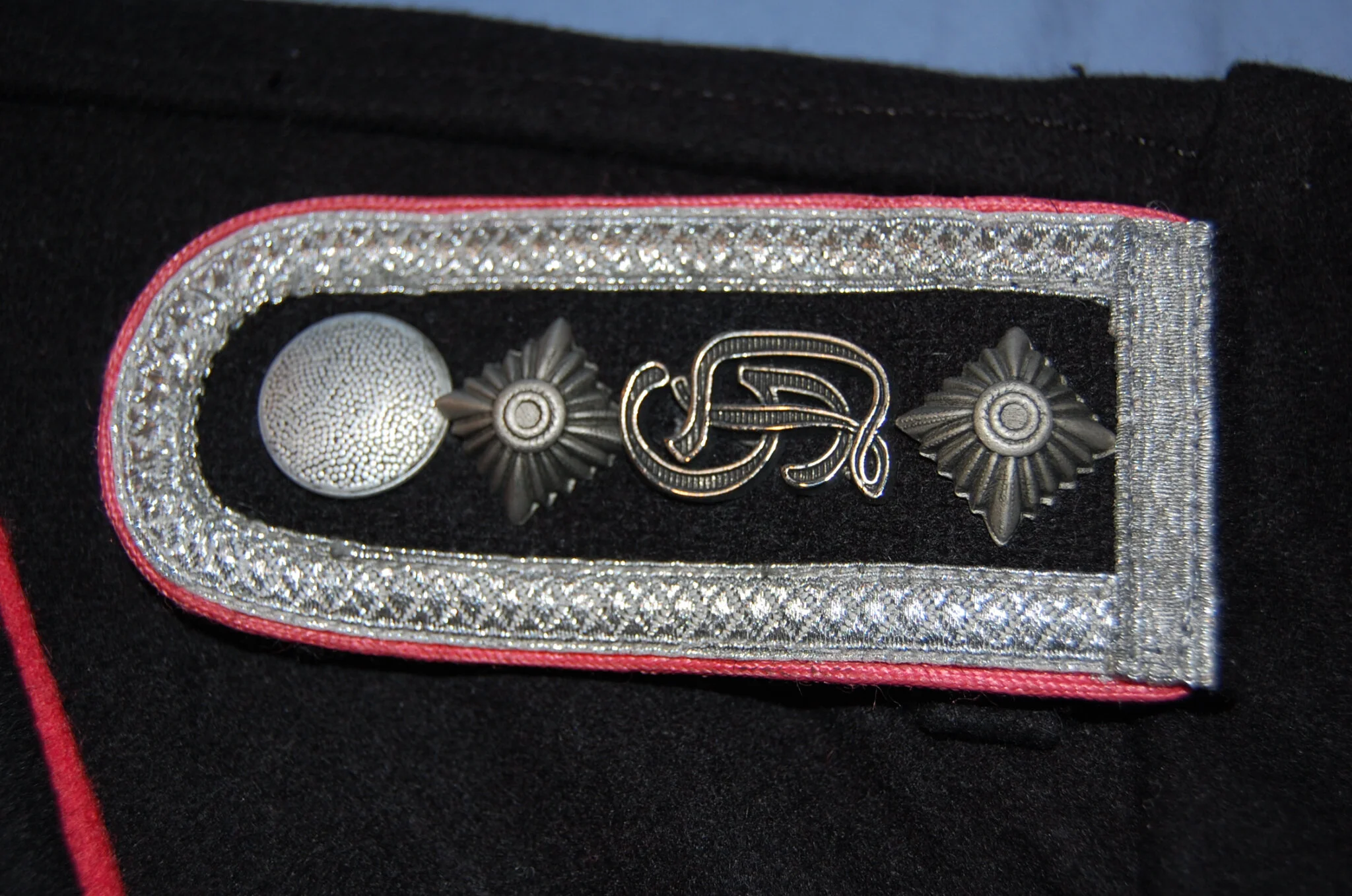








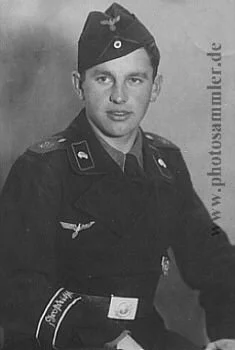







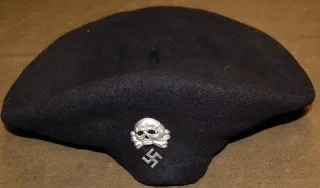











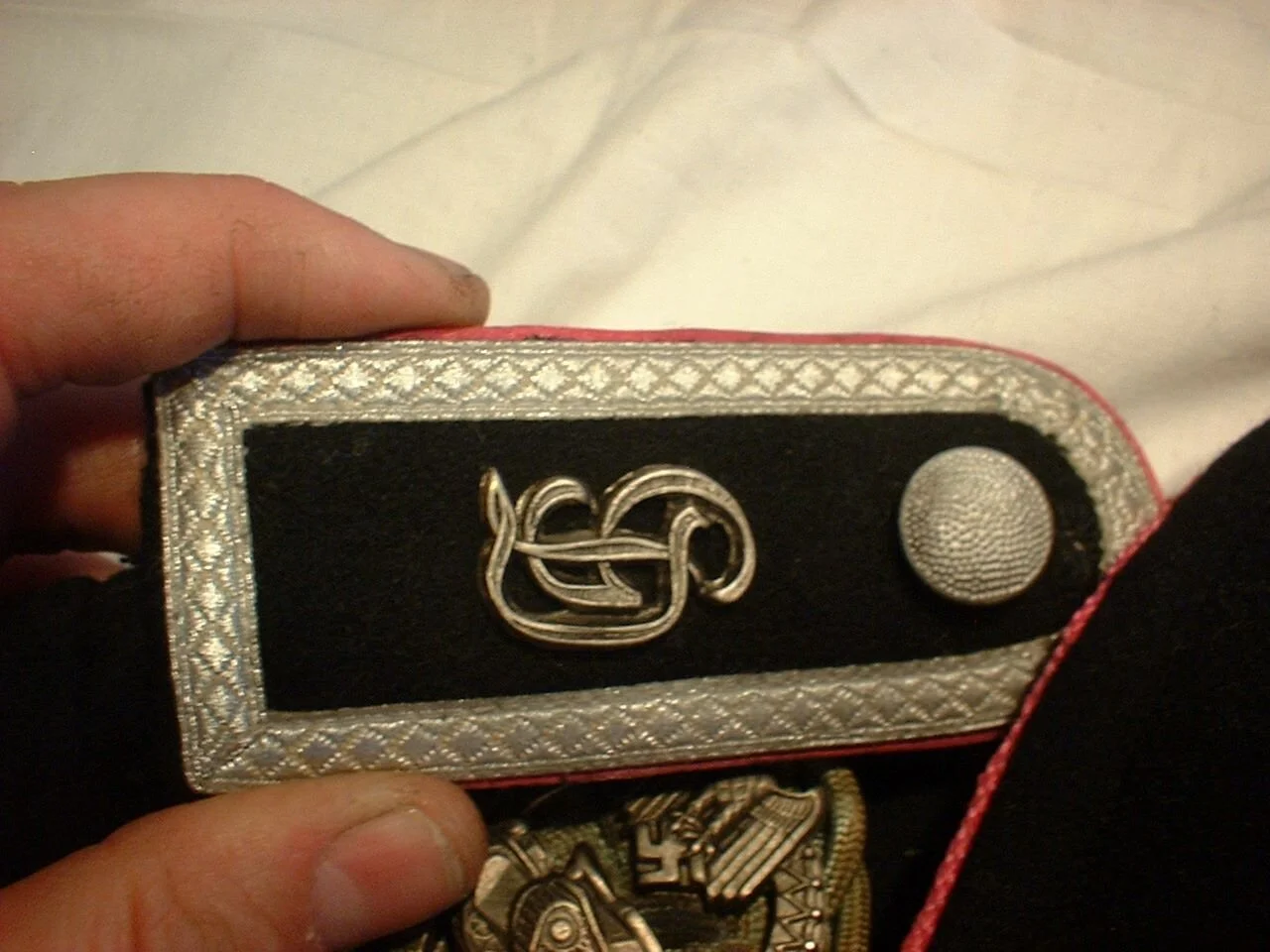

































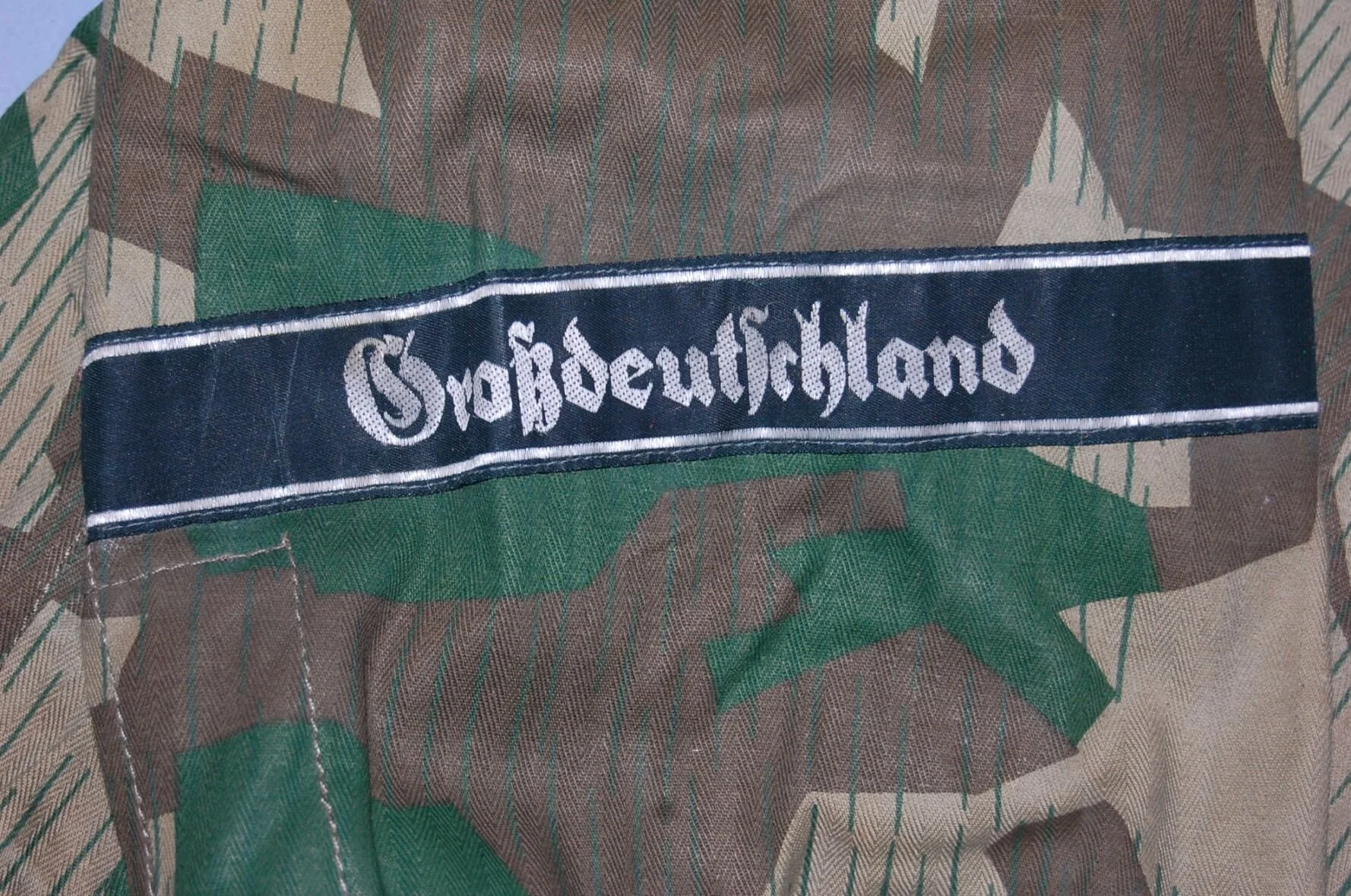









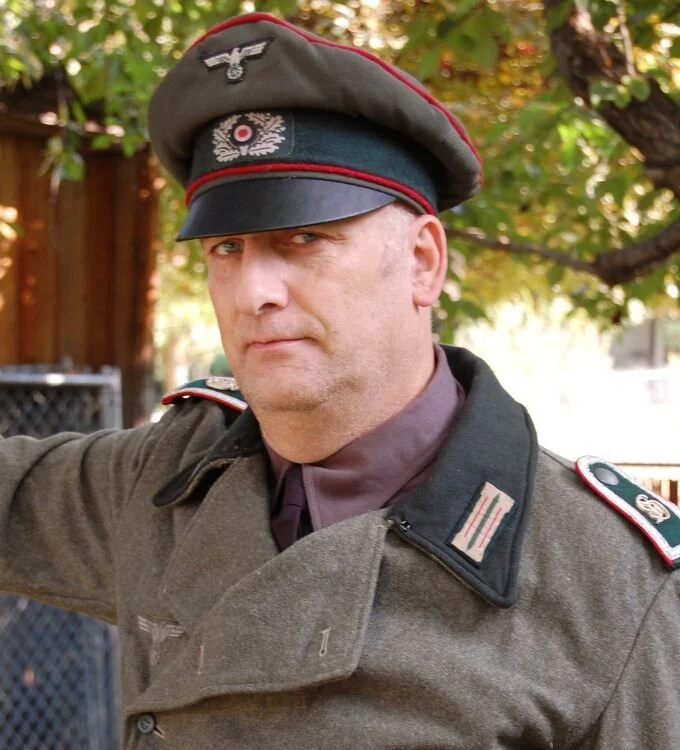
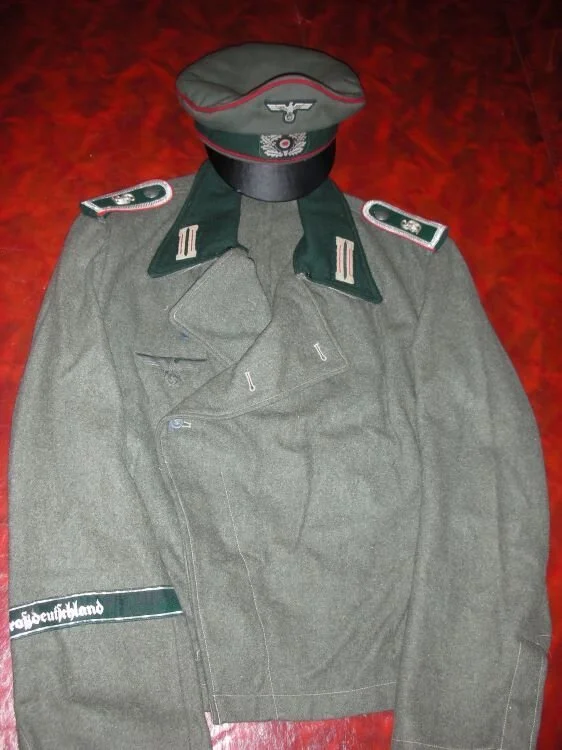
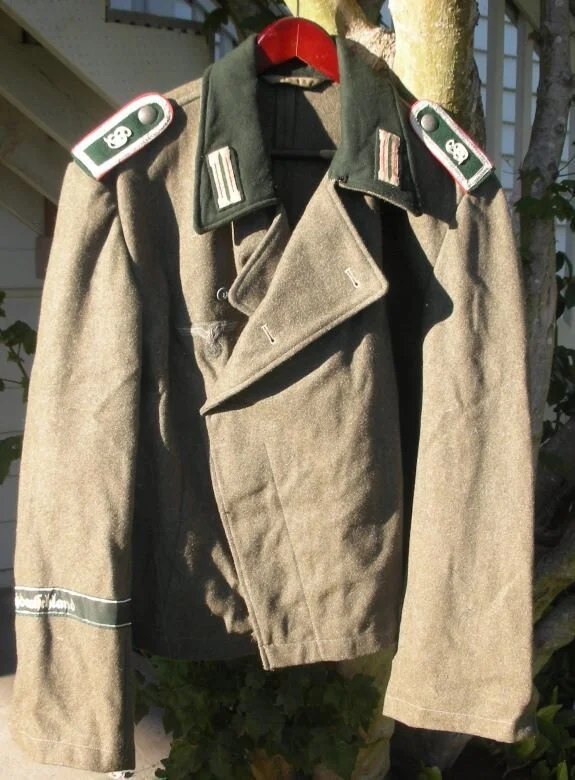
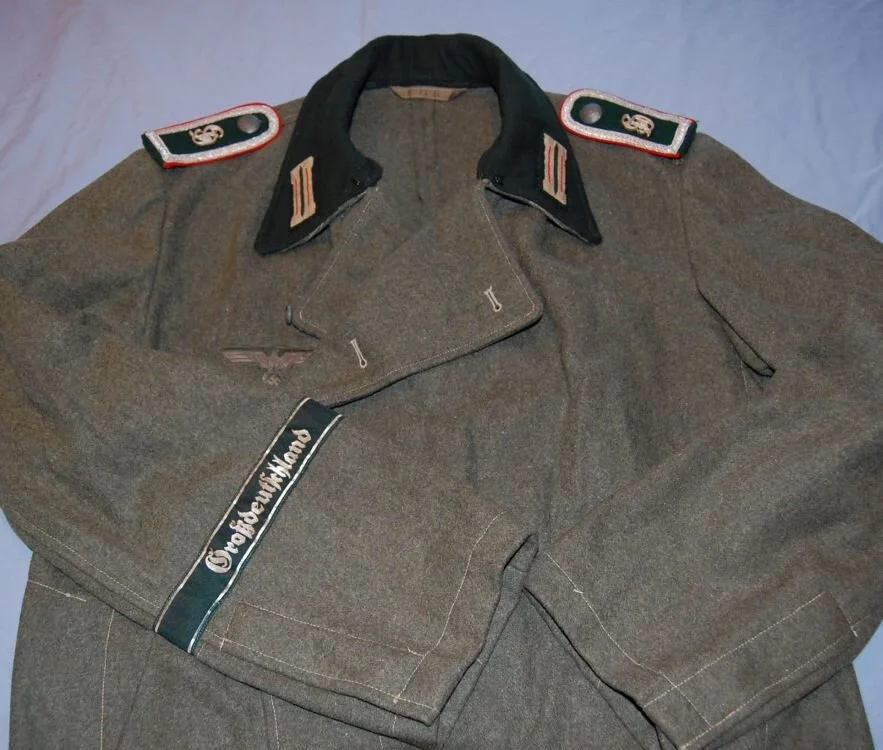
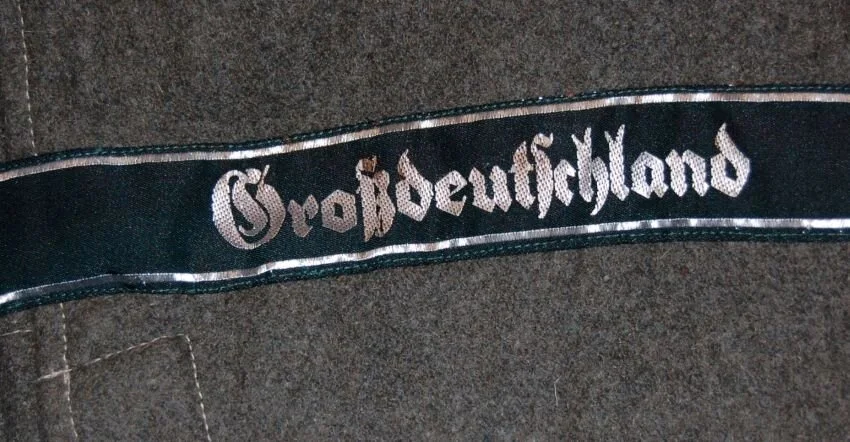
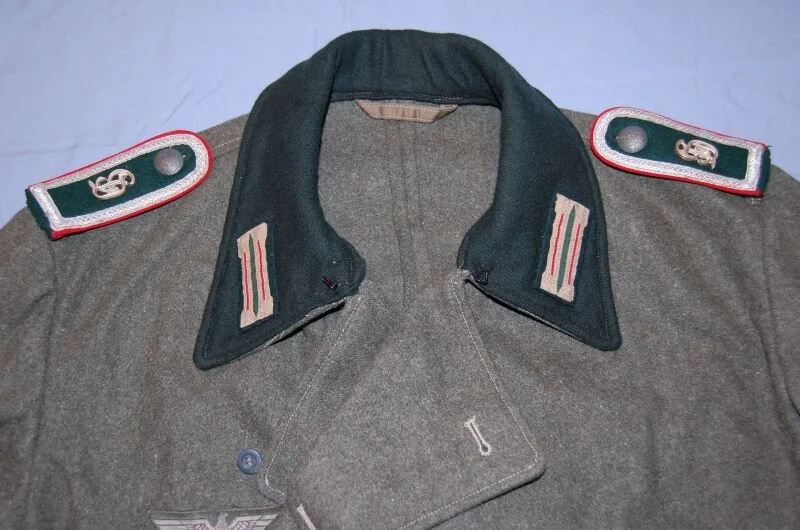
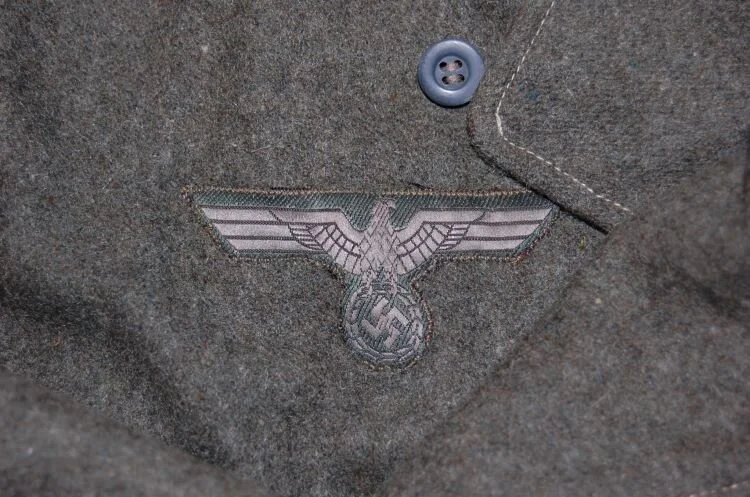
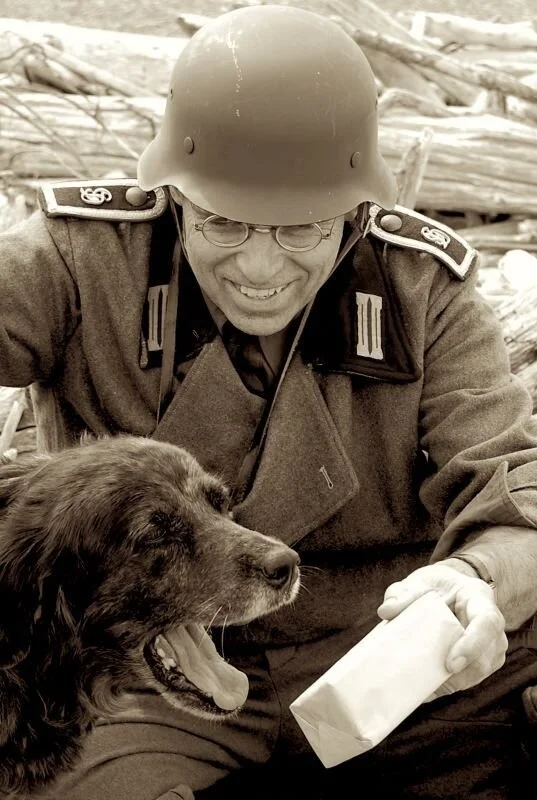





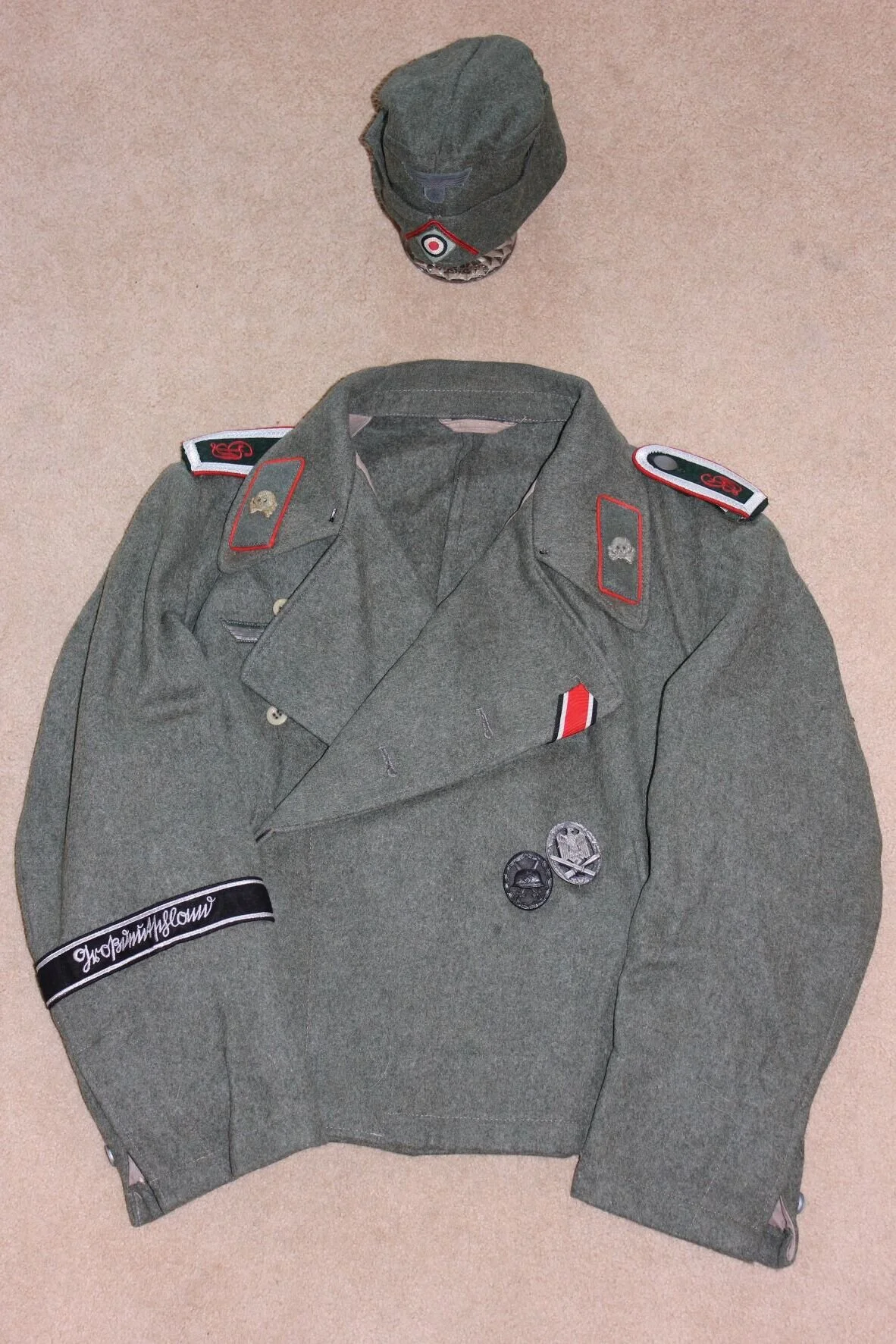

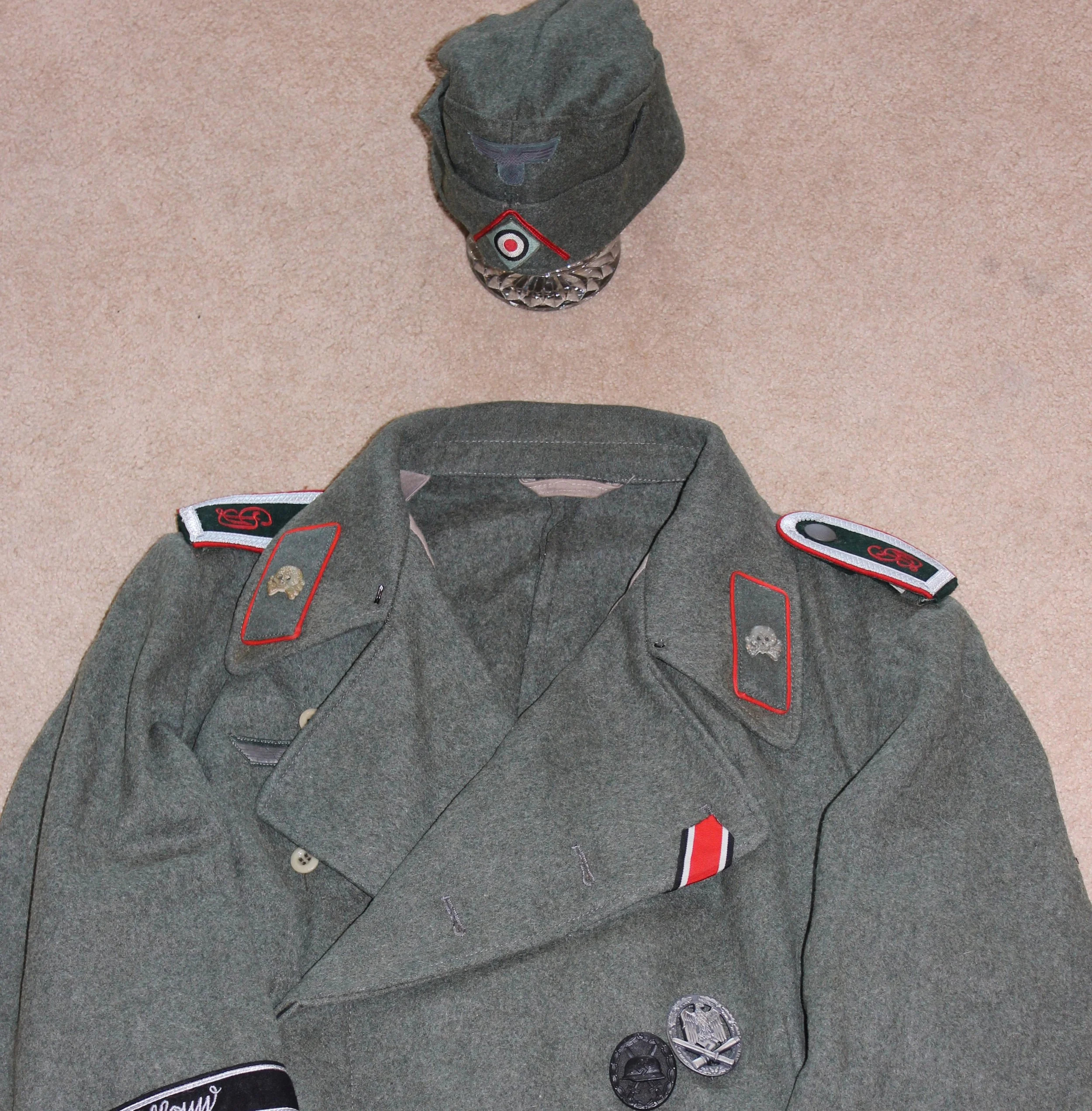















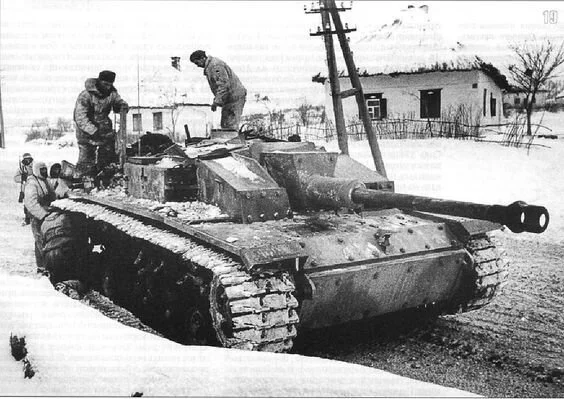

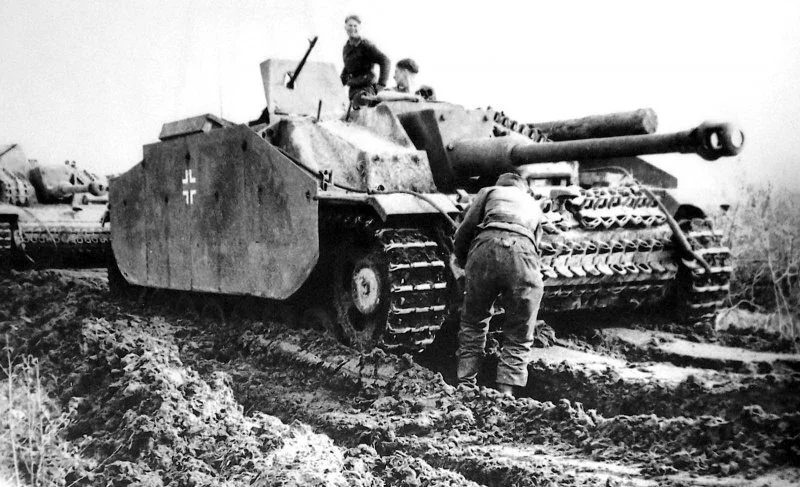




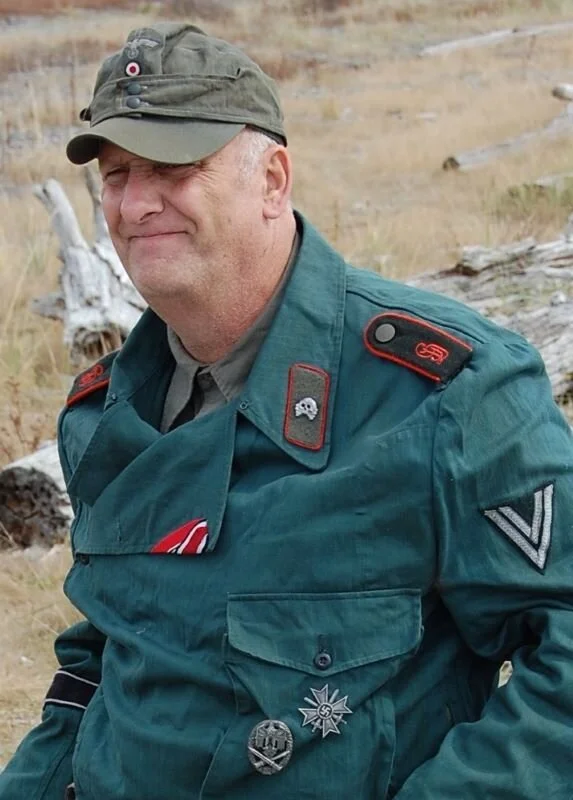


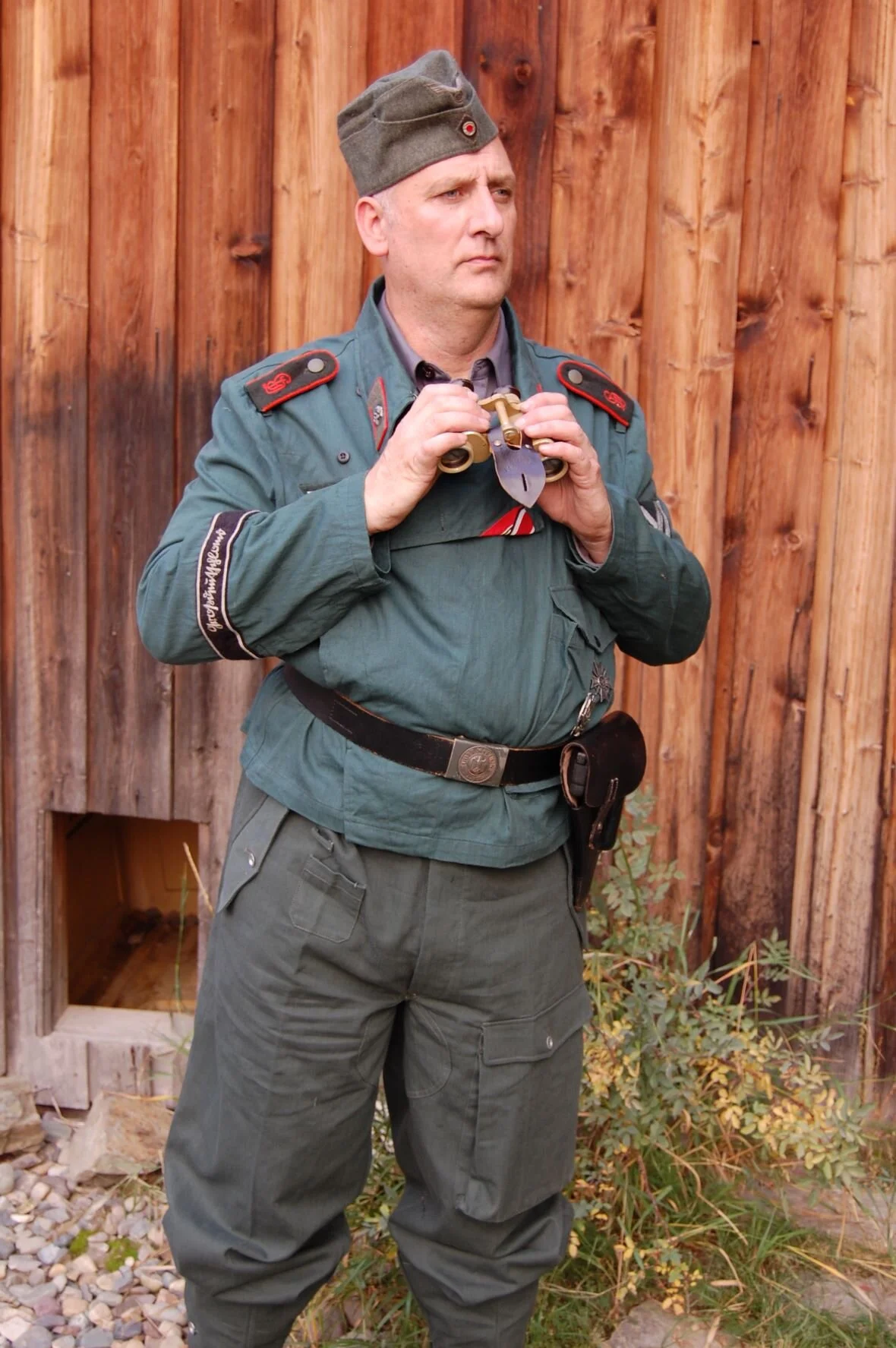





















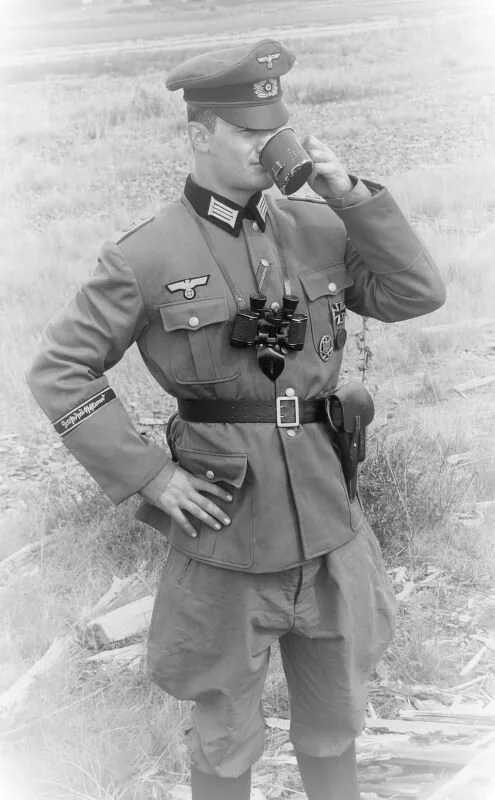




































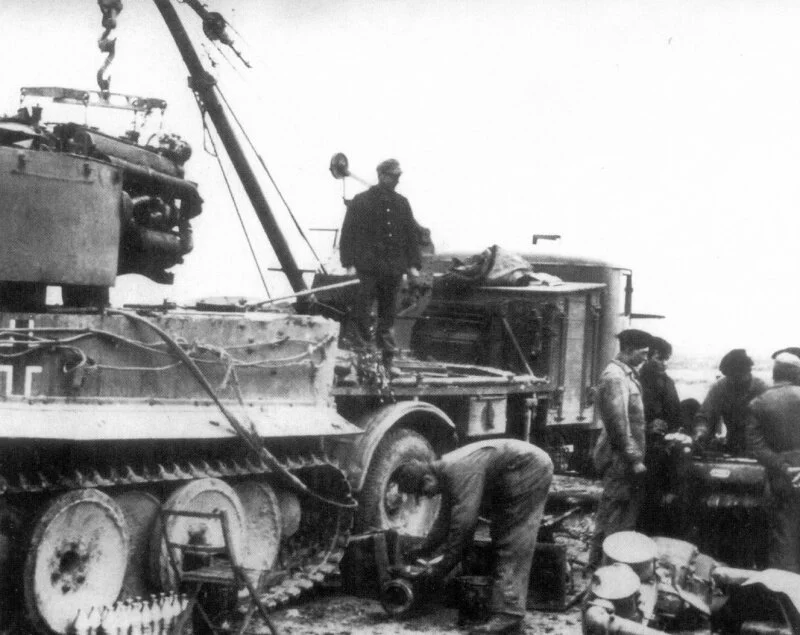










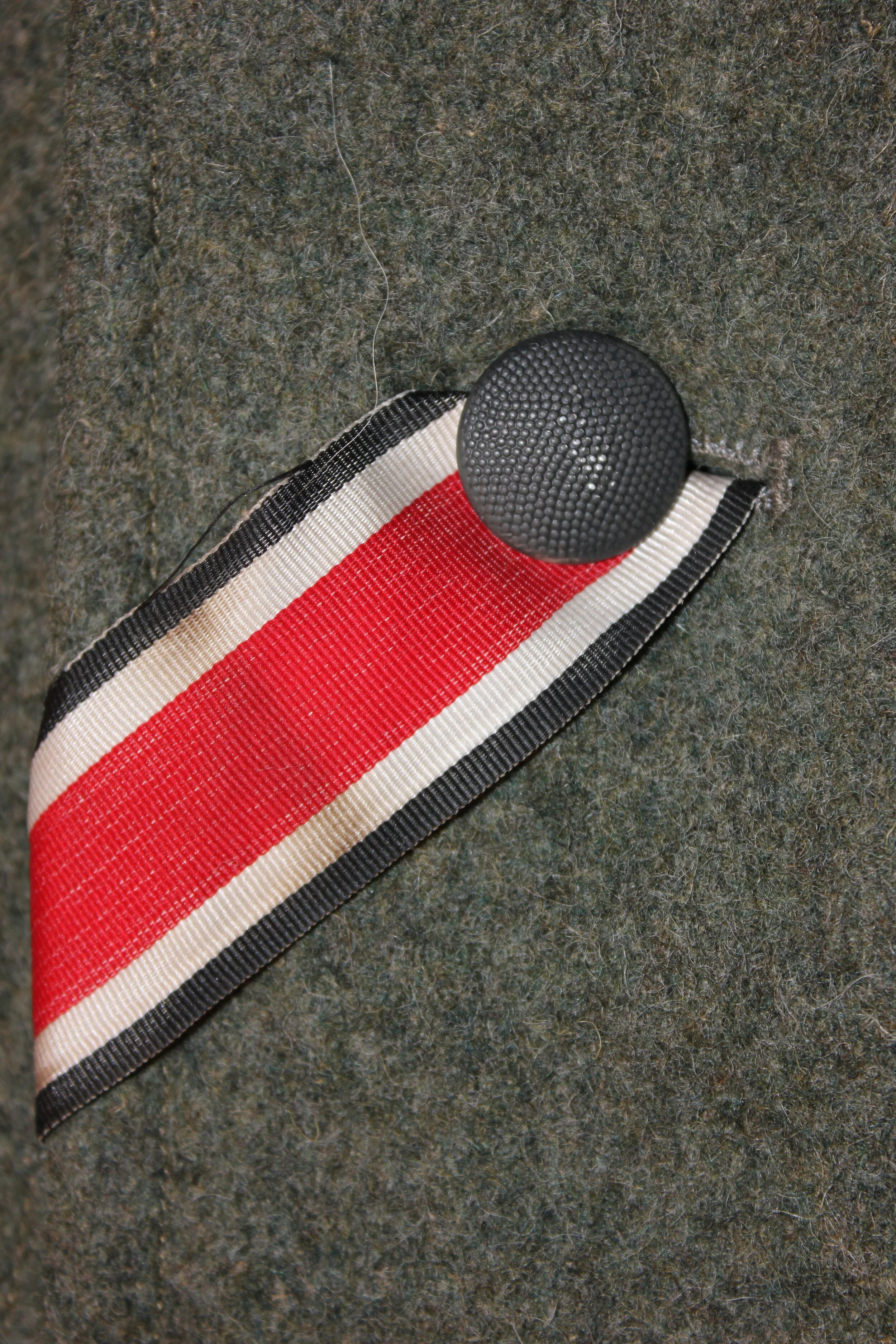
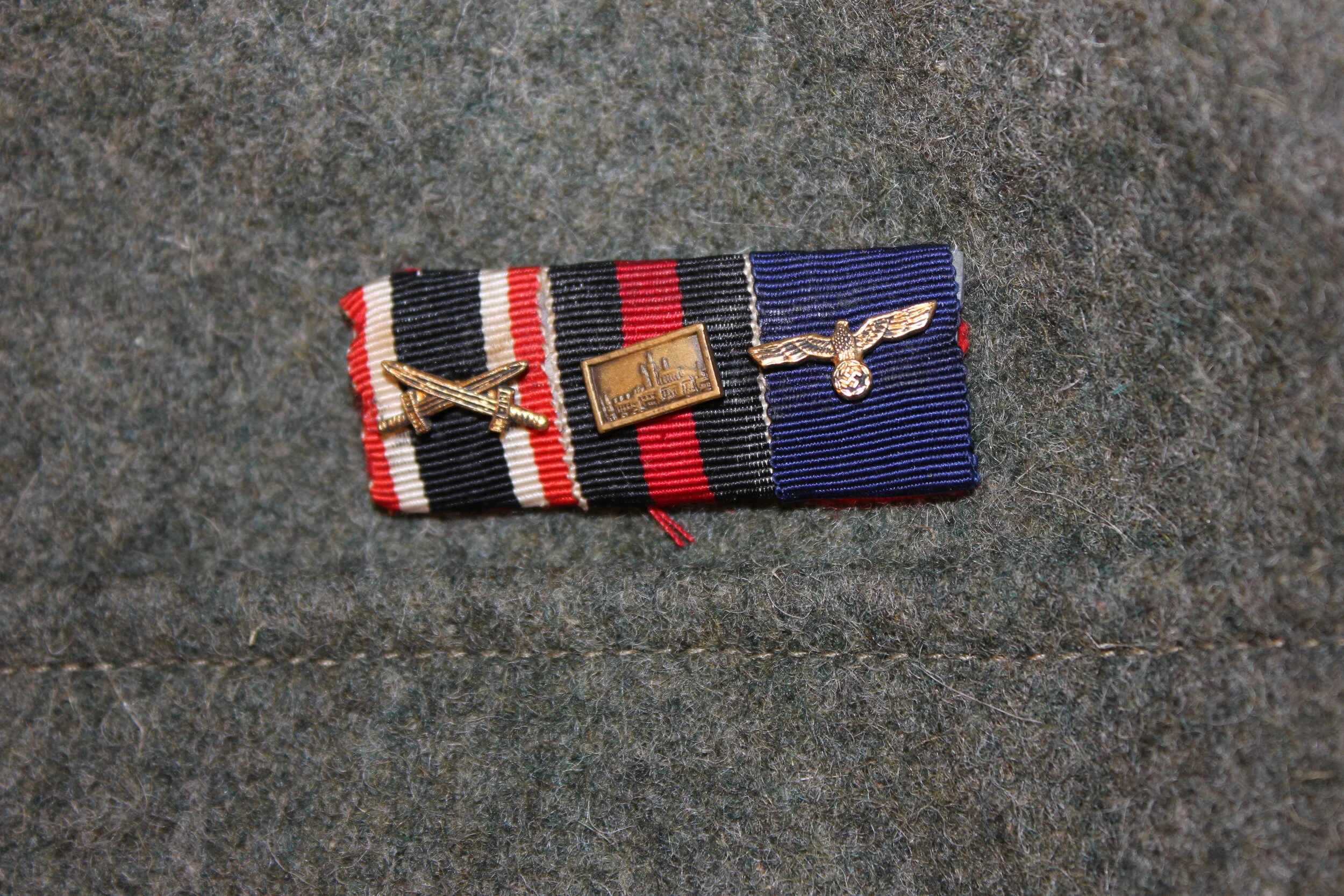





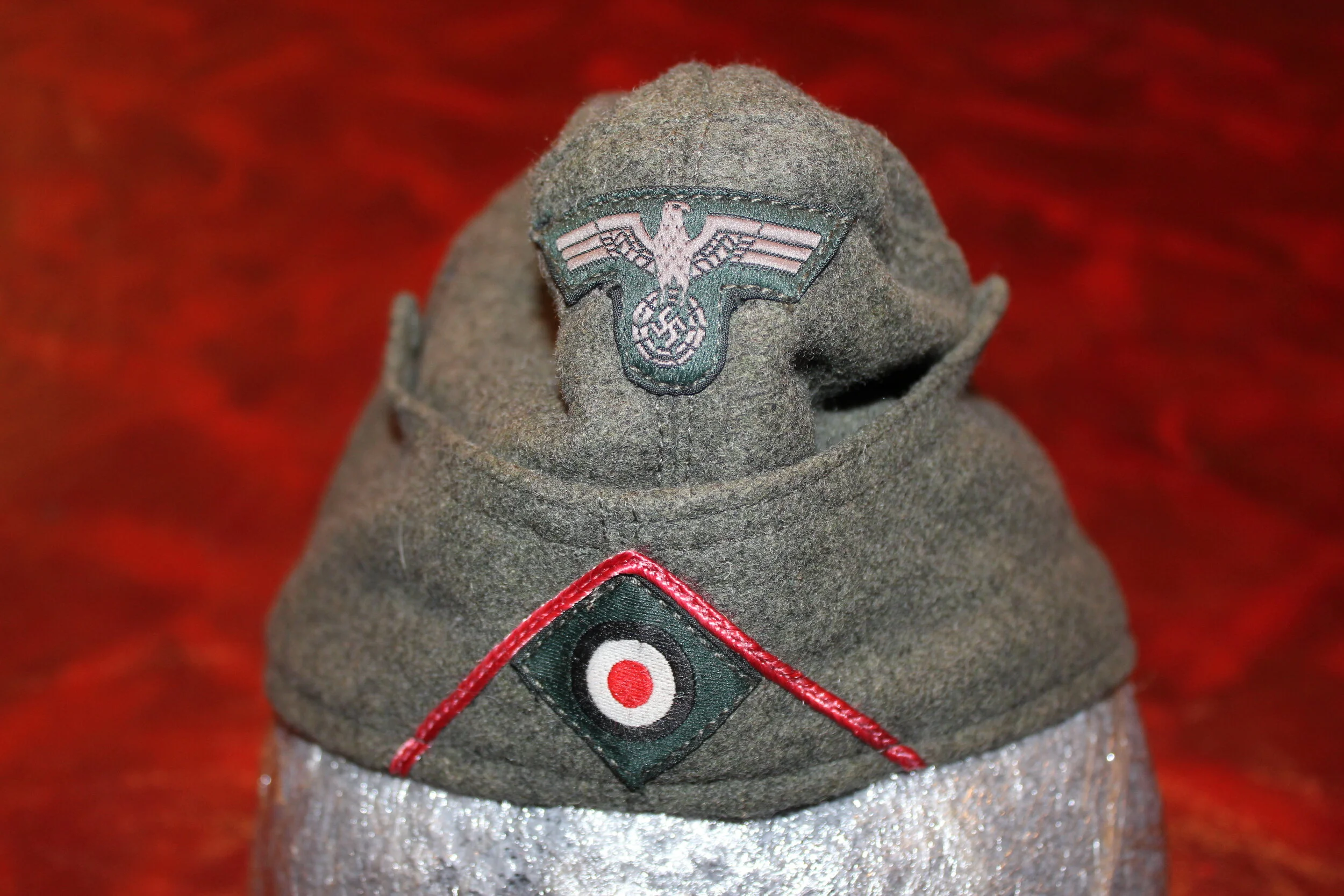






























































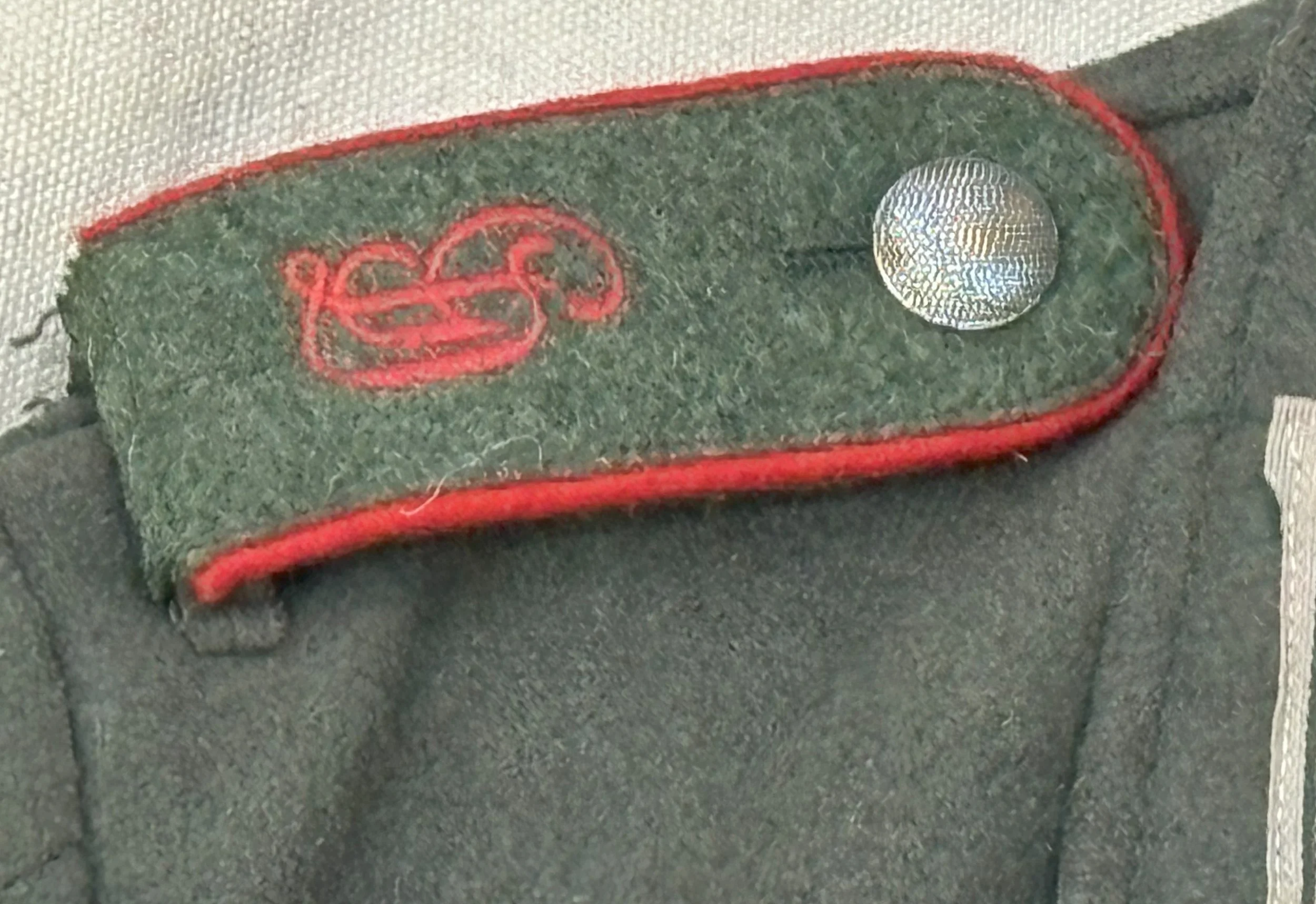

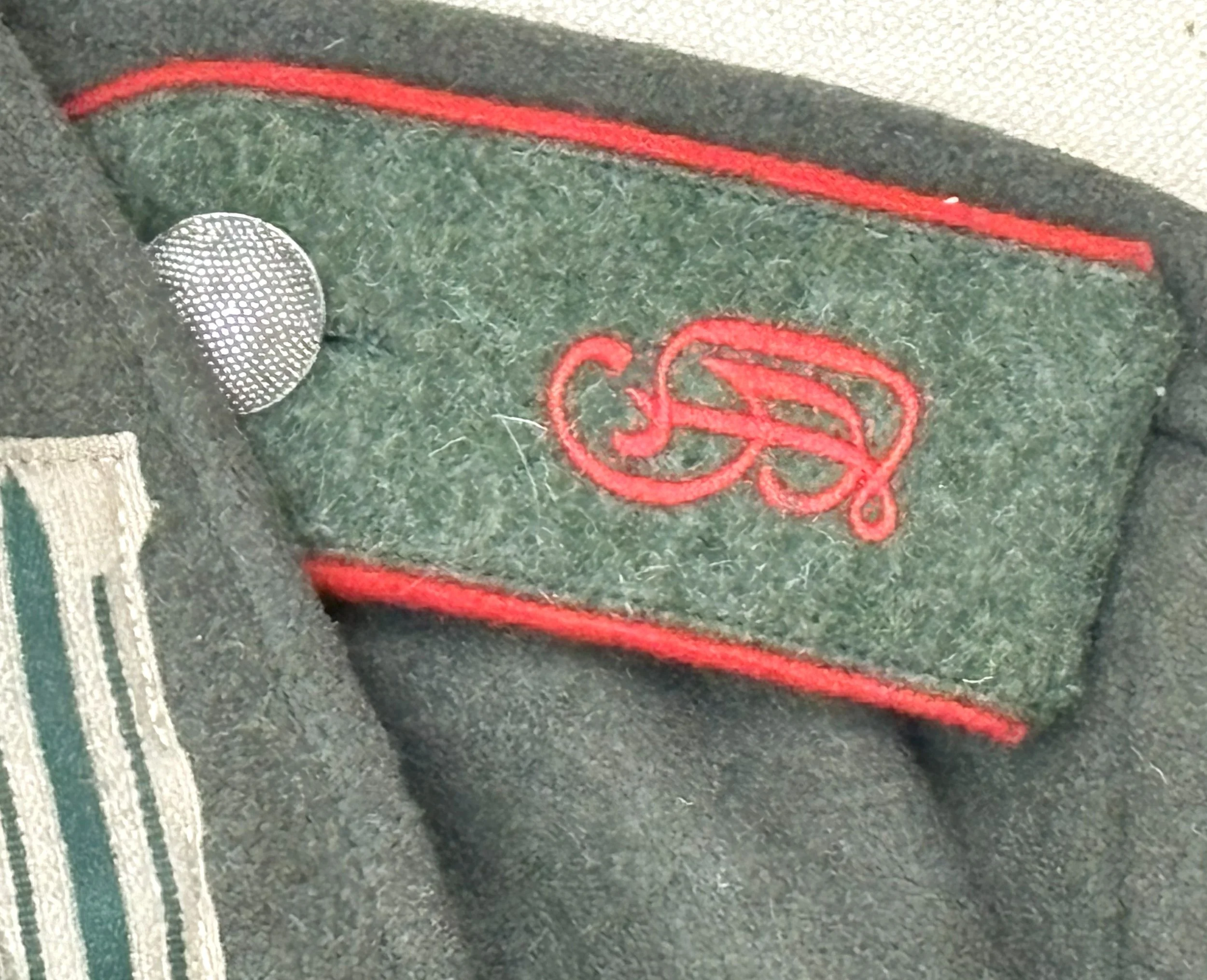



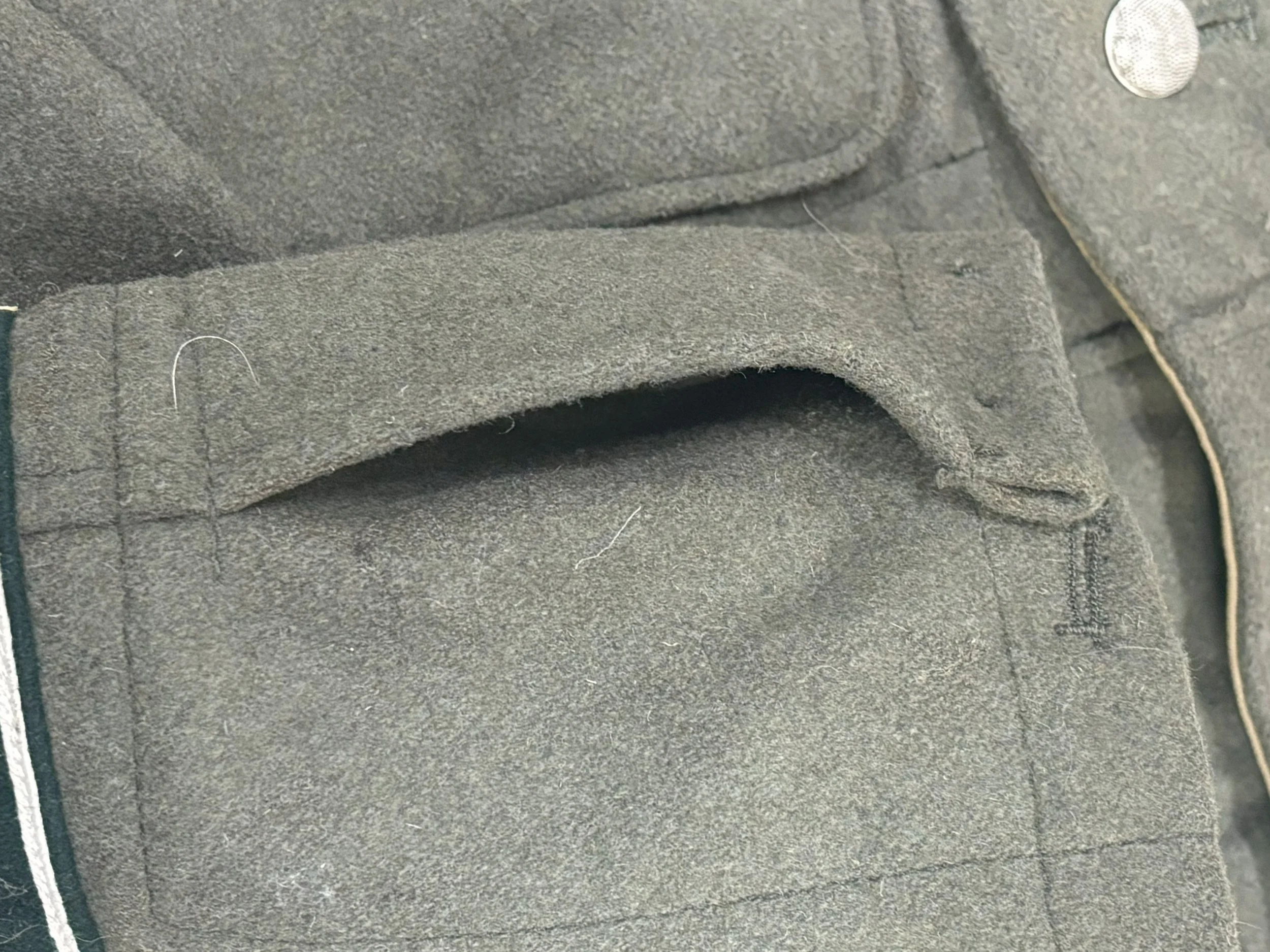
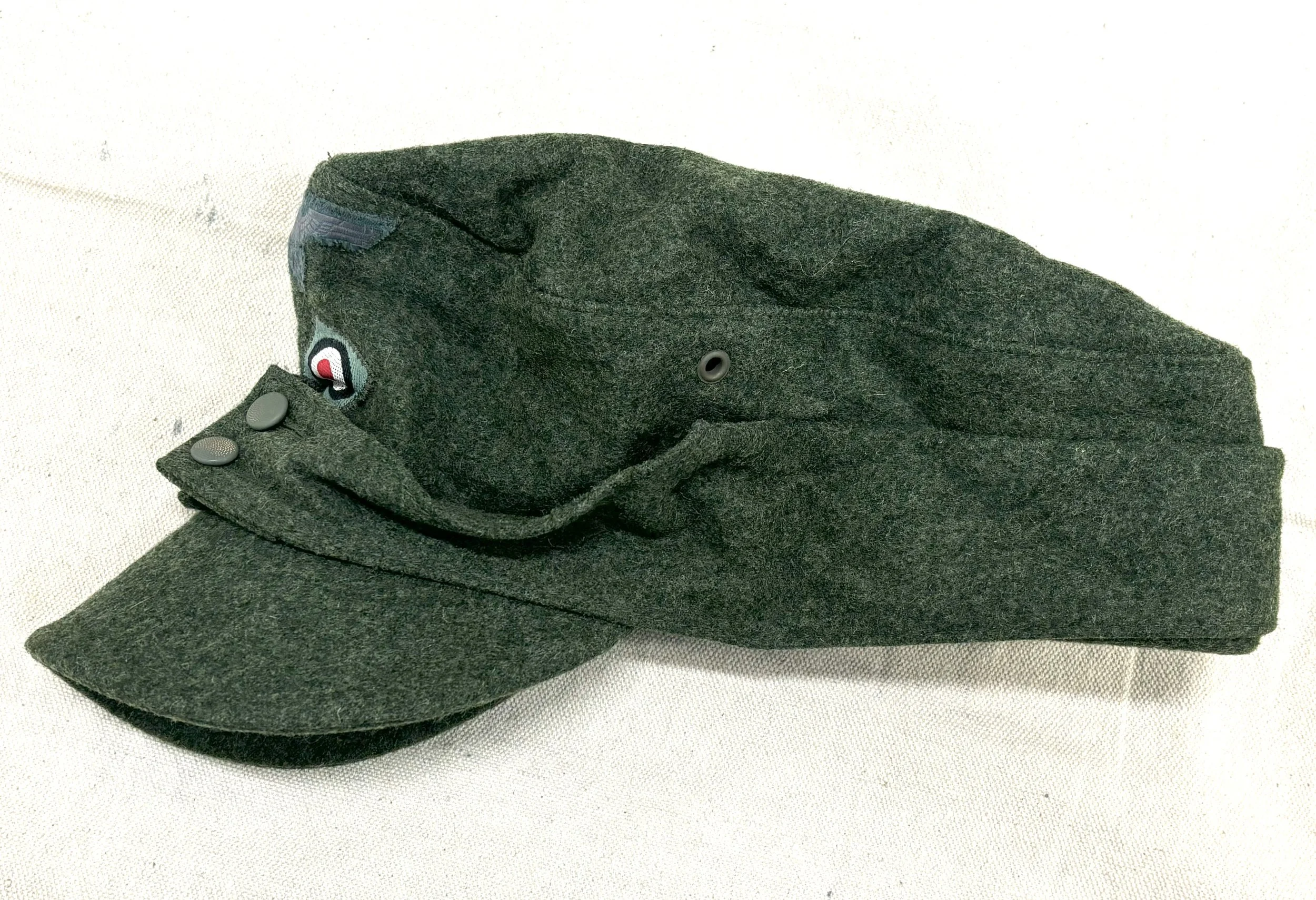

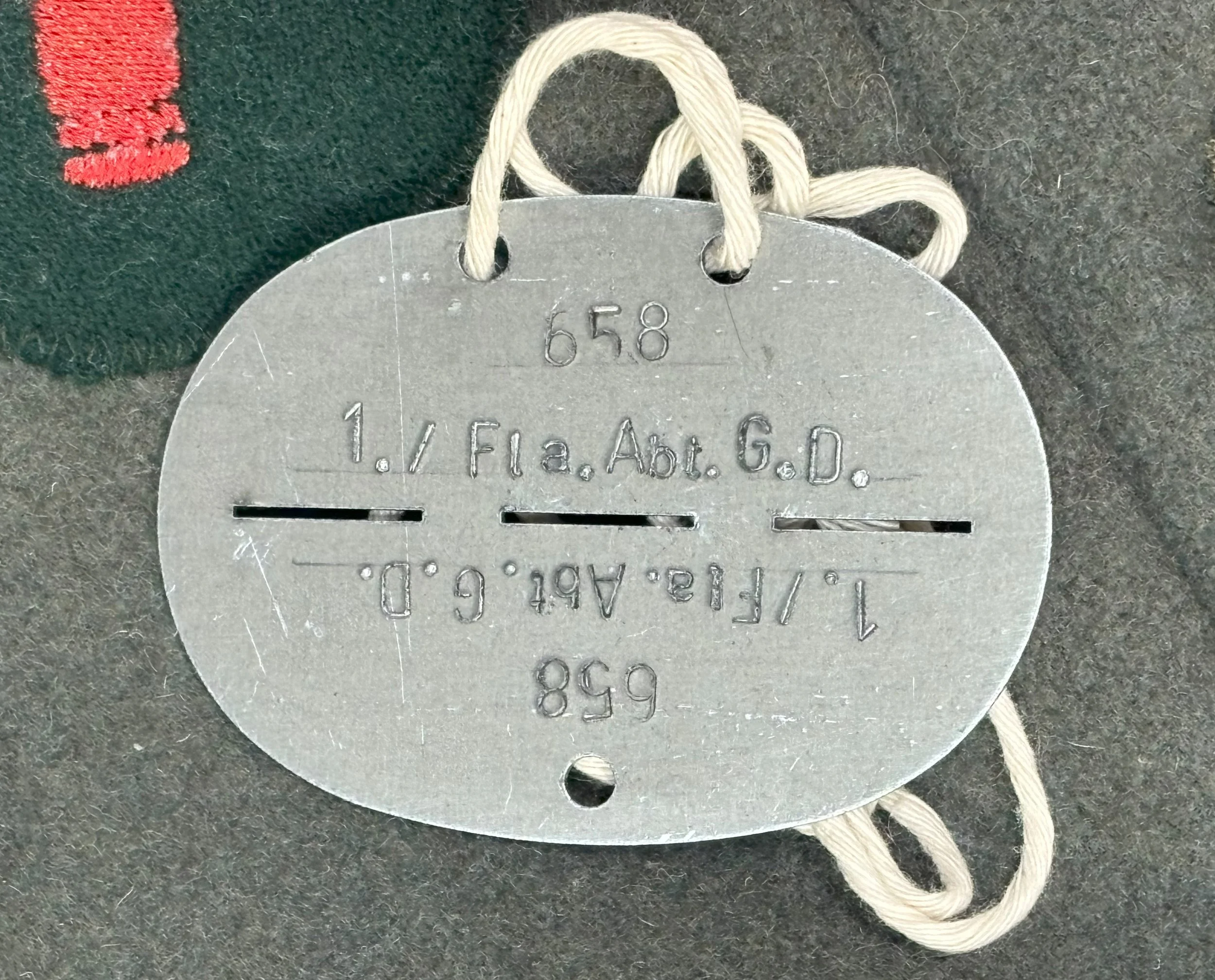





![IMG_5642[1].jpg](https://images.squarespace-cdn.com/content/v1/61355b53c1baef12641a2de9/1734224417025-GOPYNOF8BGPREGENZLX3/IMG_5642%5B1%5D.jpg)




![IMG_5643[1].jpg](https://images.squarespace-cdn.com/content/v1/61355b53c1baef12641a2de9/1734224421843-AEJWG2AB2WOVPUORJGHB/IMG_5643%5B1%5D.jpg)















































